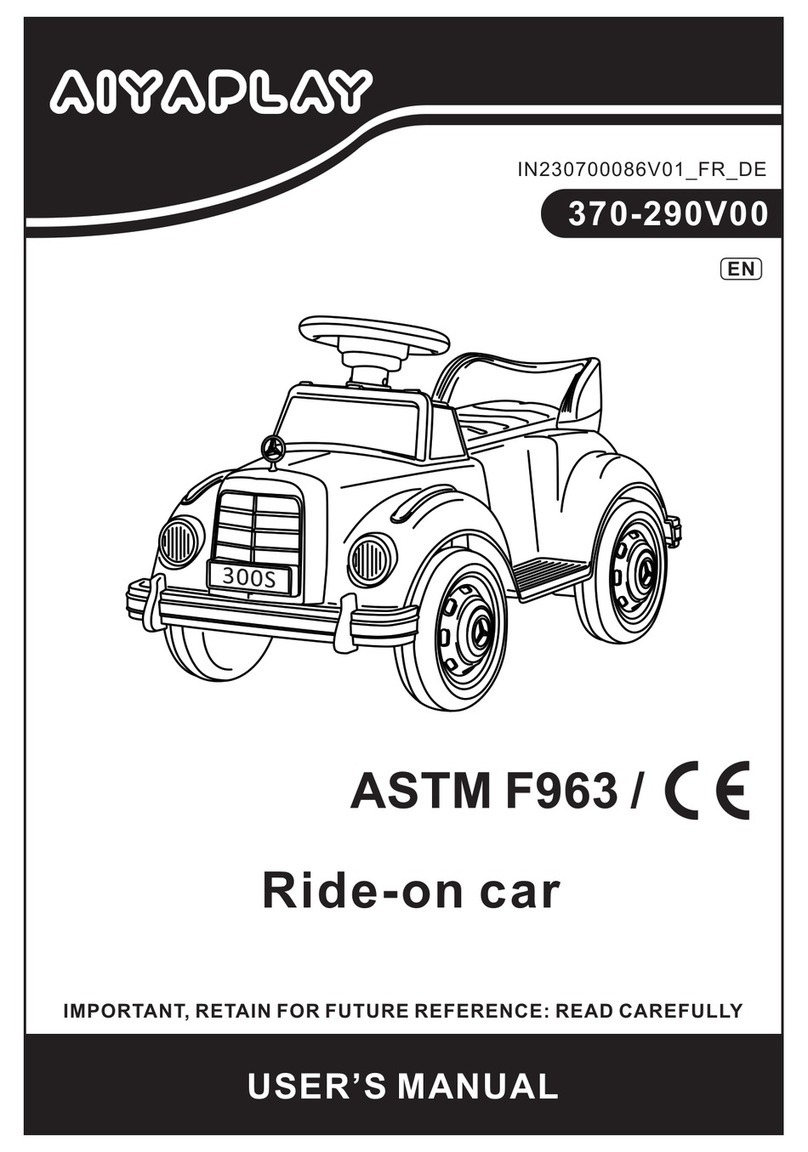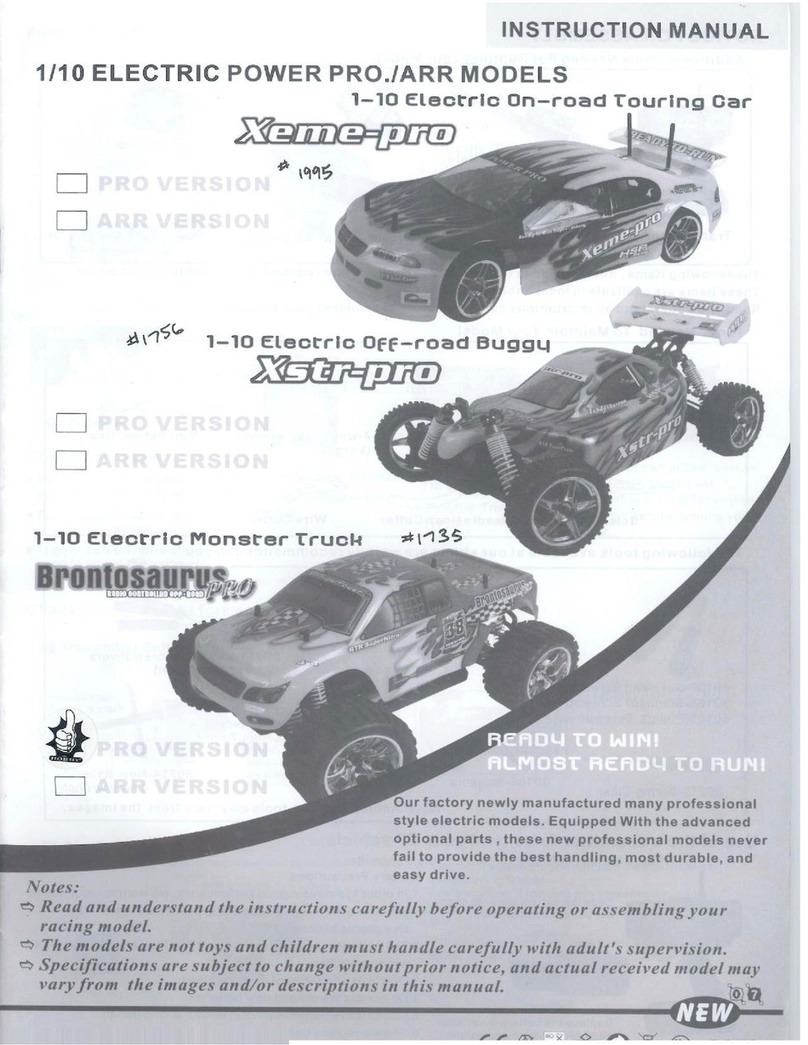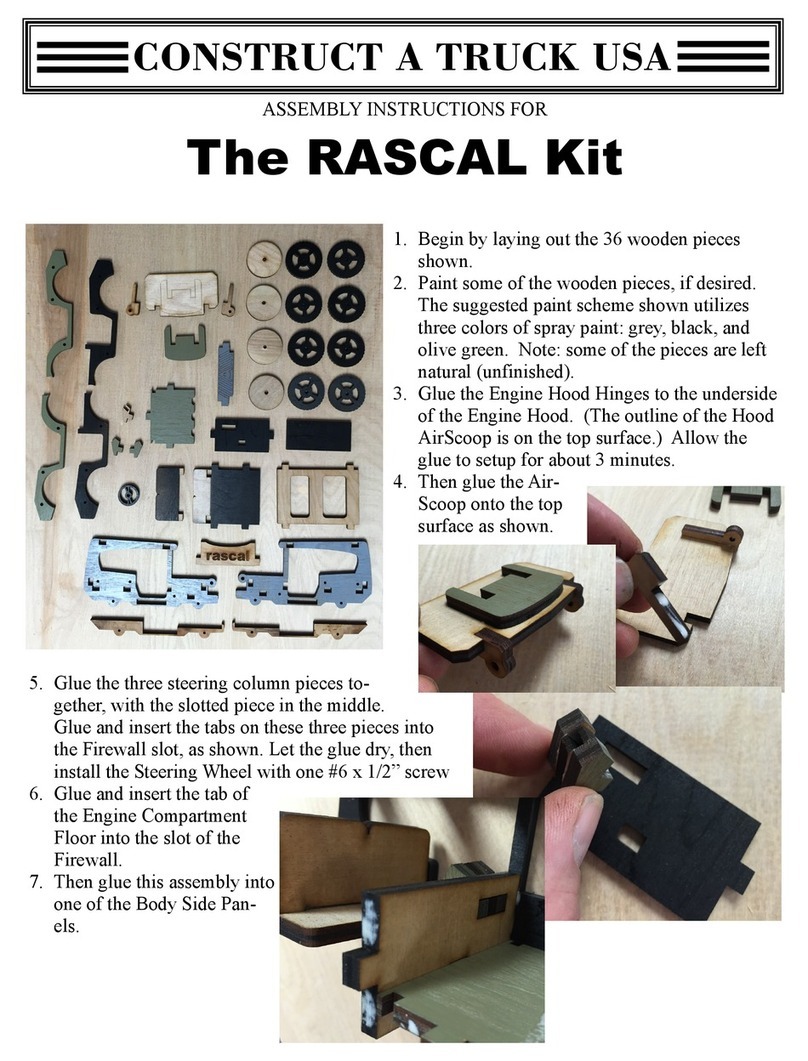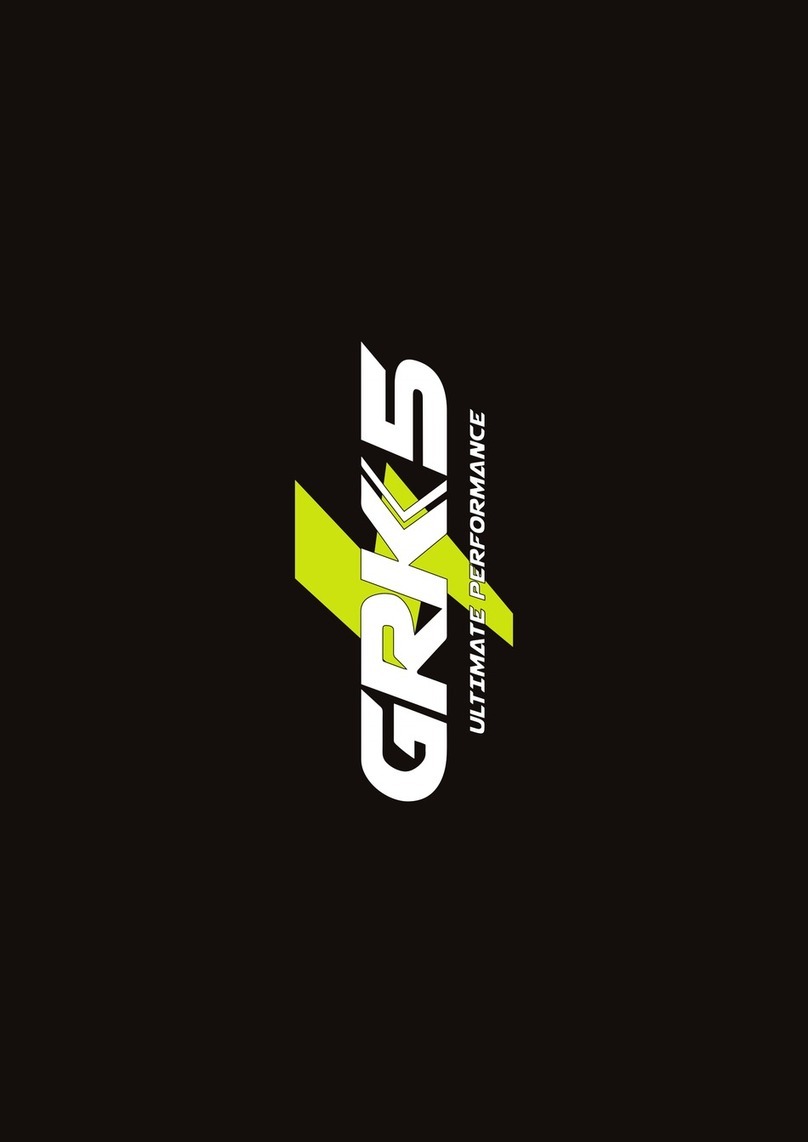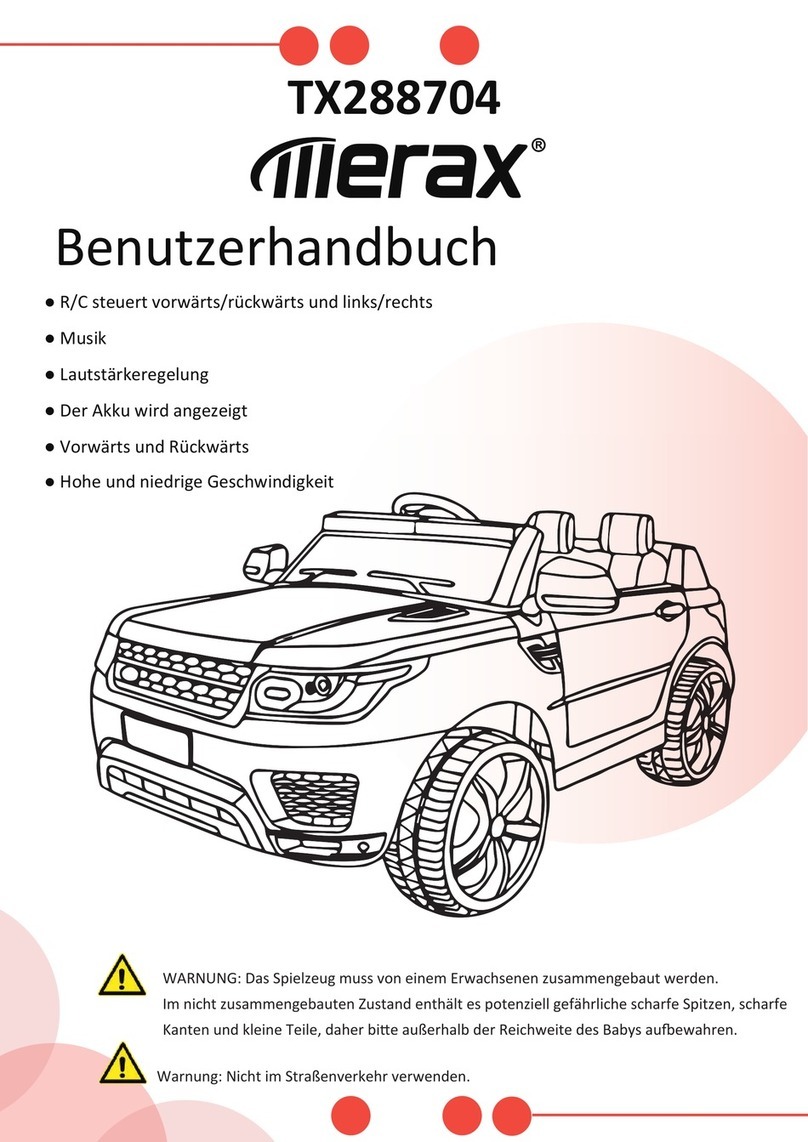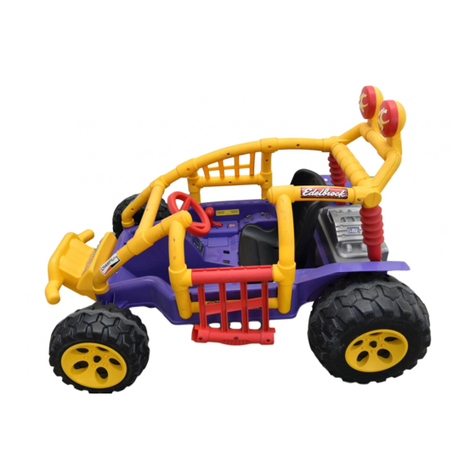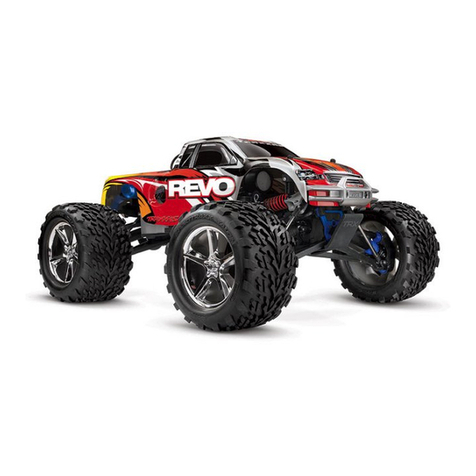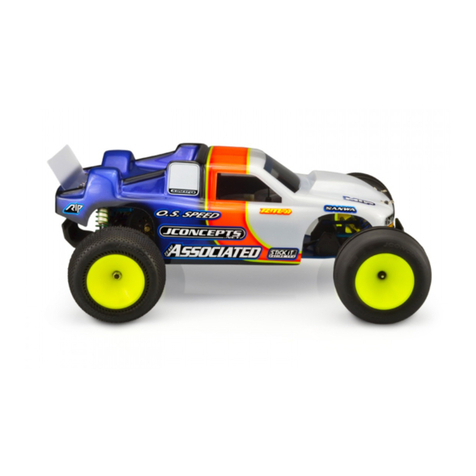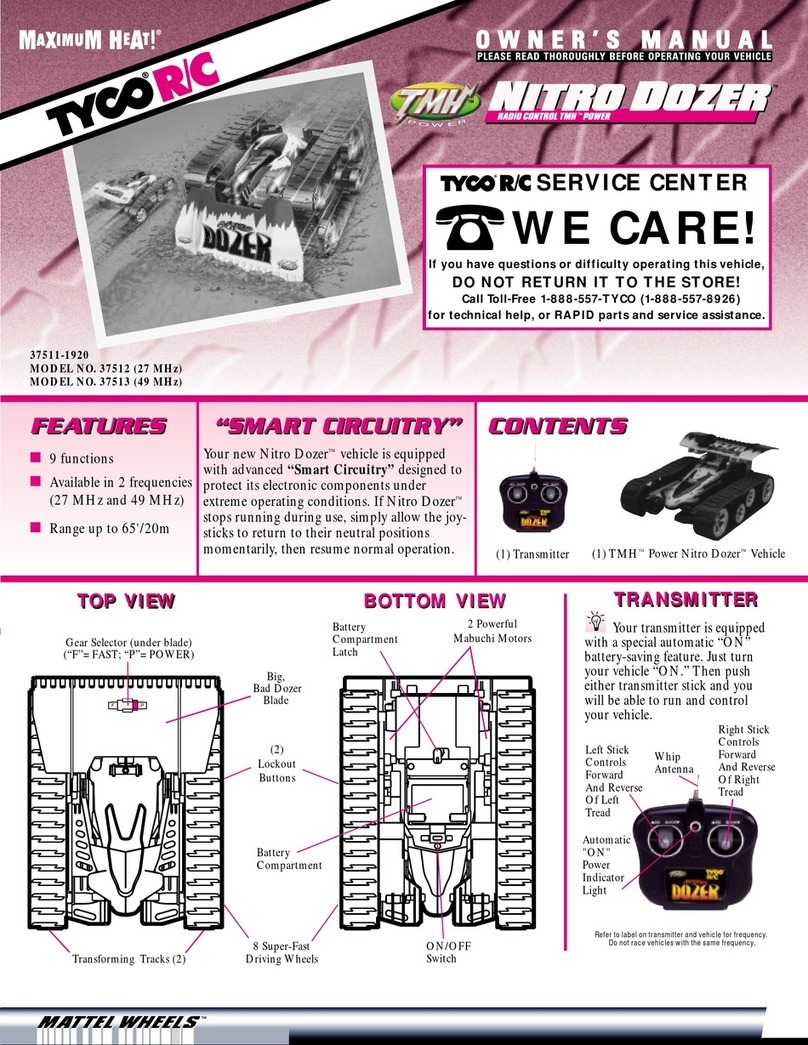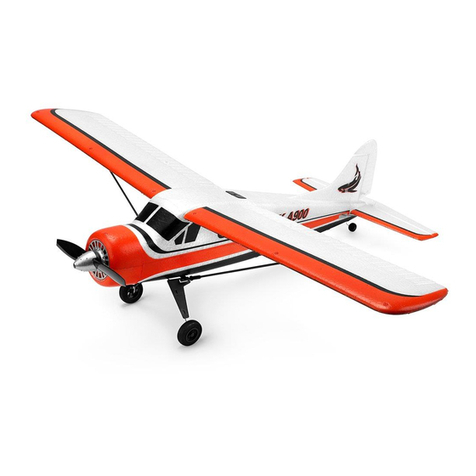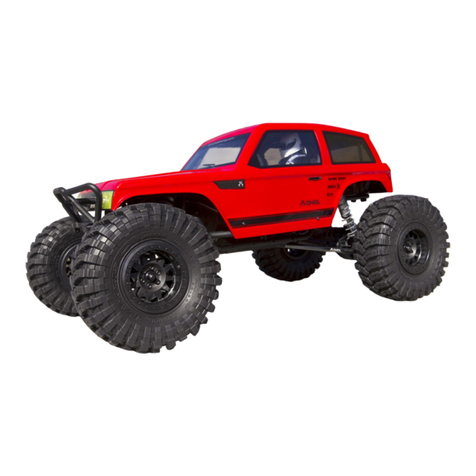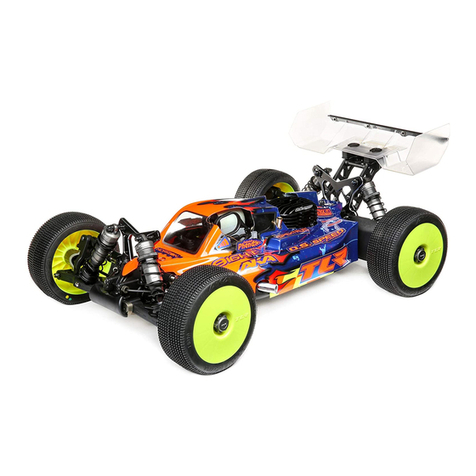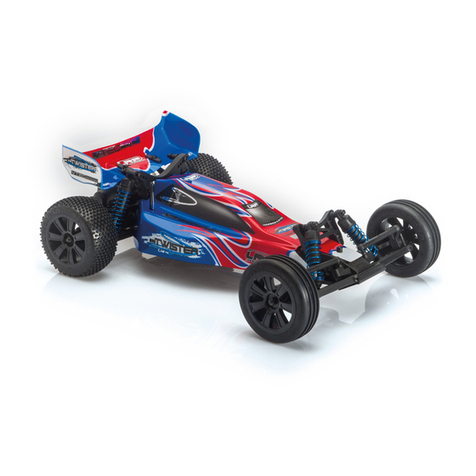ROBBE MAN TGA XXL 8x4/4 User manual

MAN
TGA XXL
41.660 8x4/4
No. 3301
Assembly and operating instructions
Montage- en gebruiksaanwijzing

2

MAN TGA XXL 41.660 8 x 4/4
3
Specification
Overall length: approx. 557 mm
Overall width: approx. 215 mm
Width of driver’s cab: approx. 170 mm
Height incl. roof spoiler: approx. 270 mm
Wheelbase, 1st and 2nd axles: approx. 180 mm
Wheelbase, 2nd and 3rd axles: approx. 100 mm
Wheelbase, 3rd and 4th axles: approx. 95 mm
Rear axle track: approx. 148 mm
Front axle track: approx. 144 mm
Weight incl. complete RC system: approx. 4500 g
Motor speed: approx. 6500 rpm
Reduction ratio, motor gearbox: 5.5 : 1
Reduction ratio, rear axles: 2.8 : 1
Power supply: 12 V
Scale: 1 : 14.5
General notes regarding construction and the radio con-
trol system:
The building instructions are divided into sub-assemblies,
each of which is sub-divided into individual stages arranged
in a logical sequence. All the sub-assemblies are numbered.
Each stage is accompanied by an assembly drawing which
clarifies the procedures involved. To help you identify the
correct items, each assembly drawing also includes a full-
size representation of the screws, washers and shim was-
hers required for that stage.
Each stage also includes supplementary Hints and Tips
which apply to the procedures currently in hand.
All the pushrod lengths and servo output arm lengths stated
in the building instructions assume the use of robbe /
Futaba servos.
If you wish to use other makes or types of servo, these
dimensions may need to be altered slightly.
Please see the separate accessory sheet for details of the
tools and accessories required to complete and operate
the model.
Keep all the supplementary sheets and these building
instructions in a safe place, in case you need to carry out
repairs or re-assembly work later. We recommend that you
also keep all the supplementary sheets supplied in the kit.
If you have a complaint or wish to make a claim under gua-
rantee, please note that it is essential to state the Check
Number and provide proof of purchase (receipt).
Notes on building the model:
Three different symbols are used repeatedly throughout
these instructions:
1: Cyano-acrylate glue (“cyano”)
- Use cyano for these joints.
2: Grease tube
- Use grease (robbe No. 5532) at these points.
3: Loctite
-Use Loctite medium-strength thread-lock fluid
(robbe No. 5074) at these points.
It is essential to de-grease the screw threads before apply-
ing thread-lock fluid.
Tip: Loctite should always be used very sparingly, otherwi-
se excess fluid may run into ballraces and plain bearings
and jam them. It is often best to apply the fluid into the
threaded hole itself.
Notes on painting the model
Our recommended colour scheme
Grey primer 400 ml
Clear lacquer 400 ml
Chassis components,
heavy-duty turret components
Transport red, RAL 3020, gloss 400 ml
Heavy-duty turret components,
saddle coupling, mudguards, mirrors
Solid black, RAL 9005, gloss 400 ml
Driver’s cab
Signal yellow, RAL 1003, gloss 150 ml
Wheels
Metallic silver, gloss 150 ml
The stated paint quantities are approximate figures; more or
less may be required according to your preferred method of
application.
Most modellers will wish to paint the vehicle in the colour
scheme of their choice.
We therefore recommend that you start by assembling the
complete basic vehicle, as this will allow you to decide
which parts are to be painted, and in which colours. You can
then remove these parts, paint them, and only then install
them permanently. This applies in particular to parts which
have to be glued in place.
The model is designed in such a way that most components
can be removed at any time. This makes it possible to chan-
ge the vehicle’s configuration and radio installation when
you wish to do so.
Stage 1, installing the servos and the leaf-springs
Tip: most makes of servo are fitted with a splined output
shaft.
By repeatedly rotating the output disc through approxima-
tely 90° it is normally possible to find a position where the
output disc is more or less exactly perpendicular to the
servo case sides.
The raised lines on the output discs will help you orientate
them correctly.
It is not absolutely essential to fit the user-prepared out-
put discs as shown, but they do alleviate the problem of
unwanted differential travels which can result when a con-
Assembly and operating instructions No.
3301

MAN TGA XXL 41.660 8 x 4/4
4
ventional cruciform output device is used. We also
recommend the use of servo travel limiting at the trans-
mitter, as this provides a means of optimising the steering
travels.
- Prepare the 35 mm Ø output disc 1.1 as shown in the dra-
wing. The basic discs are included in the servo accessory
pack.
-Drill all holes 1.5 mm Ø.
- Distances of the three lines of holes from the centre: 7.5
mm / 10 mm / 12.5 mm.
- Attach the linkage ball 1.3 to the centre hole in the row
using the screw 1.4 and washer 1.2. Using this hole
makes it possible to adjust the steering travels on the
second axle - if necessary - by moving the ball to the insi-
de or outside hole.
- Screw the prepared output disc 1.1 to the servo.
- Install the servo 1.6 in the ladder frame from the undersi-
de, using the screws 1.7.
- Fix the leaf-springs 1.11 / 1.12.1 and 1.12.2 to the ladder
frame as shown in the drawing, using the screws 1.9, the
washers 1.10 and the leaf-spring bushes 1.13.
Stage 2, preparing the front axles
- Press the ballraces 2.2 into the wheel bearers 2.1 and
slide the wheel axles 2.3 through.
- Fit the washers 2.4 on the wheel axles 2.3, fit the dowel
pins 2.5 through the holes in the wheel axles, set them
central and secure them with a drop of thread-lock fluid.
- Insert the plain bushes 2.7 in the front axle.
- Fit the prepared wheel bearers in the front axles using the
screws 2.8; tighten the screws just to the point where the
wheel bearers swivel freely, but without lost motion.
Stage 2.1, assembling and installing the front axle wheels
- Fit the wheel adaptors 2.9 on the wheel axles, and secu-
re them with the nuts 2.10.
- Insert the hubcaps 2.11 in the wheel adaptors.
- Pull the tyres 2.13 onto the wheels 2.12 and secure them
with a little cyano.
- Fix the wheels to the wheel adaptors using the hex-head
screws 2.14. Use the 3.2 mm A/F box spanner (supplied)
for this.
Stage 3, preparing the rear axle differentials
- Fit one ballrace 3.1, two spacer washers 3.2 and one fur-
ther ballrace 3.1 onto each of the half-shafts 3.3.
-Insert the prepared half-shaft assemblies in the differenti-
al 3.4, and engage the circlips 3.5.
-Screw the bevel gear 3.6 to the differential housing using
the countersunk screws 3.7.
Stage 3.1, assembling the rear axle housing
- Axle No. 3:
- Place the prepared differential assembly 3.1 - 3.7 in the
axle shell 3.8.
-Fit the ballrace 3.10 and the pinion 3.11 on the drive shaft
3.9, and secure the pinion by lightly tightening the grub-
screw 3.12.
- Lay two assemblies 3.9 - 3.12 in the axle shell.
- Function check: when you turn the drive shaft 3.9, the
half-shafts 3.3 should rotate smoothly.
- Tighten the grubscrews 3.12.
- Lubricate the bevel gears and bearings with Teflon grea-
se.
- Place the second axle shells on top and fit the self-tap-
ping screws 3.13 and 3.14 to hold the parts together.
- Axle No. 4:
- Place the prepared differential assembly 3.1 - 3.7 in the
axle shell 3.8.
- Fit the ballrace 3.10 and the pinion 3.11 on the drive shaft
3.9, and secure the pinion by lightly tightening the grub-
screw 3.12.
- Lay one assembly 3.9 - 3.12 in the axle shell.
- Function check: when you turn the drive shaft 3.9, the
half-shafts 3.3 should rotate smoothly.
- Tighten the grubscrew 3.12.
- Lubricate the bevel gears and bearings with Teflon grea-
se.
- Insert the plug 3.17.
- Place the second axle shells on top and fit the self-tap-
ping screws 3.13 and 3.14 to hold the parts together.
Stage 3.2, rear axle wheels
- Assemble the tyres and wheels as described for the front
axle, and attach them.
Stage 4, installing the axles
-Note: the wheels and tyres have been omitted from this
drawing in the interests of clarity.
- Turn all the wheels round to “face the front” (i.e. for for-
ward running) before installing the rear axles.
- Axle No. 3: check the direction of rotation of the articula-
ted output shaft: it must turn in the same direction as axle
No. 4 relative to the rotation of the input shaft.
- Front axle No. 1 only: install the leaf-springs 4.7.
-Screw the linkage balls 4.12 in place, then snap the link
pushrod 4.9 - 4.10 onto the balls.
Drawing
! Drehrichtung = ! Direction of rotation
--
Assembly and operating instructions No.
3301

MAN TGA XXL 41.660 8 x 4/4
5
Stage 5, pushrods
- Press the ballraces 5.3 and shim washers 5.2 into the
bellcrank 5.1.
- Assemble the pushrods and set them to the stated lengths.
- Assemble the bellcrank, the socket-head screw 5.4, the
washer 5.5 and the spacer bush 5.6, and place it against
the underside of the ladder frame as shown. Fit the nut
5.7 to secure the bellcrank.
- Attach the linkage ball 5.8 to the front hole in the axle bea-
rer on the second axle using the self-tapping screw 5.9.
- Screw the ball-end bolt 5.10 into the rear hole in the axle
bearer on the first axle. If it is difficult to “start” the screw,
carefully open up the hole using the tip of a sharp balsa
knife.
- Connect the prepared pushrods as shown.
Stage 6, latch and tipping mechanism
- Fit the nuts 6.2 on the threaded rods 6.1 (projecting by
about 1 - 2 mm) and slip them through both sides of the
ladder frame, working from the inside. Install the alumini-
um bush 6.3, the shim washer 6.4, the ballrace 6.5 (flan-
ge on the inside), the shim washer 6.7 and the nut 6.8.
Secure the nuts 6.2 and 6.8 with a drop of Loctite.
-Fit the latch crank 6.6 on the ballrace 6.5 and add the
connecting piece 6.12, the hook 6.11, the screw 6.9 and
the washer 6.10.
- Note: the latch hooks 6.11 are aligned later, when the dri-
ver’s cab has been installed.
- Temporarily attach the tipping brackets 6.13 and 6.14
using the screws 6.16 and the washers 6.15.
-The prepared tipping bracket assembly can now be atta-
ched temporarily to the ladder frame using the screws
6.18 and the washers 6.17. Insert the pivot screws 6.19.
- Note: the fixings for this sub-assembly are tightened later,
when all the driver’s cab components have been trimmed
to fit and aligned correctly.
We strongly recommend that you assemble the driver’s
cab components and check all the fits before painting the
parts. This enables you to correct any production-related
manufacturing tolerances in the plastic parts by adjusting
their position in the slots.
Stage 7, installing the motor
-Insert the shaft and gear 7.2 in the gearbox housing 7.1.
-Add the articulated coupling 7.3 and secure it by tigh-
tening the grubscrews 7.4 on the machined flats in the
shaft.
- Lubricate the gear lightly with Teflon grease, and attach
the backplate 7.5 to the housing.
- Assemble the motor 7.6 and the gearbox assembly inclu-
ding the motor mount 7.7, and fix the parts together using
the socket-head screws 7.8.
-Attach the motor assembly to the ladder frame using the
self-tapping screws 7.9.
Stage 7.1, articulated shafts
- Press the shafts 7.10 and 7.12 into the articulated joints
7.11 as far as they will go.
-Place the articulated shafts between the articulated joints
on the motor and the rear axles.
- Adjust the shaft length so that about 1 mm of axial play is
present when the shafts are turning.
- Tighten the grubscrews 7.13.
Stage 8, mudguard holders
- Before installing the mudguard holders, cut eight 11 mm
lengths (8.3) and four 22 mm lengths (8.4) from the
Perbunan tube supplied.
-Screw the rearmost mudguard rods 8.2 into the threaded
holes in the ladder frame to a depth of about 5 mm.
- The remaining mudguard rods 8.4 should be screwed in
to a depth of about 2 - 3 mm.
- Tip: fit the nuts 8.2 on all the mudguard rods before instal-
ling them, as this makes it easier to maintain the proper
screwed depth.
Stage 8.1, installing the mudguards and the ladder frame
end-piece
-Note: the complete rear axle No. 4 has been omitted from
this drawing in order to show this sub-assembly more
clearly.
- Trim the rear light clusters 8.6 to fit in the rear mudguards
8.5 and glue the lamp lenses 8.7 (white), 8.8 (red) and 8.9
(orange) in place. The mudguards can be glued in place
after painting.
- Fit the mudguards 8.5, 8.10 and 8.11 on the rods, but do
not glue them in place, as it can be useful to remove them
again for later assembly and maintenance work.
Note: it is necessary to adjust the mudguard rods 8.2 so
that they extend as far as the outside edge of the mud-
guard 8.5, in order to provide sufficient support.
-Screw the frame end-piece 8.12 to the ladder frame,
keeping the edges flush, using the socket-head screws
8.13 and the washers 8.14.
Stage 9, saddle coupling
- Prepare the saddle plate 9.2 for assembly.
Note: the pushrod sub-assembly 9.8 - 9.16 is only requi-
red if you intend to install the optional coupling servo.
-Attach the saddle coupling plate 9.17 to the ladder frame
in the appropriate position, using the self-tapping screws
9.18.
- Fit the brass pivot bushes in the saddle plate 9.1, and fix
the plate to the saddle plate holder using the self-tapping
screws 9.20.
Assembly and operating instructions No.
3301

MAN TGA XXL 41.660 8 x 4/4
6
Note: do not overtighten the self-tapping screws 9.20, as
the saddle coupling needs to be able to tilt slightly when
the trailer is engaged.
Stage 10, the heavy-duty turret
-Note: please refer to the drawings showing the machine-
cut sheets in order to identify the parts described below.
Both sheets also include components required for Stage 11.
- Separate the frame components 10.1 and 10.2 from the
machined ABS sheet “A”, and clean up the edges. Repeat
the procedure with the plastic connecting pieces 10.4 -
10.6, which also have to be glued in place.
- Tip: the manufacturing process produces radiussed cor-
ners in the frame components 10.1, 10.2 and 10.6 where
they meet the plastic connecting pieces. These should be
removed using a sharp balsa knife or a small needle file,
in order to allow the parts to be joined accurately (see
drawing with parts marked bold).
-Assemble the frame components and glue all the joints
with cyano (note the 1 mm clearance and the location of
the side panels X).
- Do not glue the oval-section brass bearer tubes 10.3 in
place at this stage.
Stage 10.1, installing the moulded plastic parts
-Note: you may need to sand the “flash” from the edges of
the moulded plastic parts included in the kit in order to
obtain an accurate fit. Use medium-fine abrasive paper
(100 - 150 grit) for this.
- (A = left, B = right). Glue the guard plates 10.7 and 10.11
to the tail pipe holders 10.9 and 10.13, keeping to the sta-
ted dimensions. Glue the heat-shields 10.8 and 10.12 in
place, positioning them flush at the top.
Glue the exhaust tail pipes 10.10 and 10.14 in the tail pipe
holders (note orientation), and fix both sub-assemblies to
the frame using the self-tapping screws 10.15.
- (C) Cut the brass support shafts 10.17 for the set of four
compressed air tanks to a length of 60 mm.
- Glue the four compressed air tanks 10.18 and 10.19
together
- Separate the star-shaped retaining plates 10.16 from the
machined sheet (A), and sand the edges smooth. Fit them
on the brass shafts and set the spacing as stated in the
drawing (do not glue them at this stage).
- Position the compressed air tank assembly 10.18 and
10.19 as shown, and glue it to the retaining plates.
- Place the compressed air tank assembly in the frame. At
this point you can adjust the position of the brass shafts
to align the tanks correctly.
- (D) Prepare the oil tank sub-assembly, place it in the
frame (fit 1 x support strut 10.25 in the frame components
10.1 and 10.2).
Position the support struts carefully, and glue them in
place. The oil tank can be removed again prior to painting.
-(E + F) Prepare the dummy equipment (control console
10.31 and air dryer 10.33, 10.34) for installation on the
right-hand side of the frame, as seen from the rear. These
parts are fitted to the underside of the frame as shown in
the drawing: glue them to the bracket 10.27.
- You will find the fixings 10.28, 10.29, 10.30 and 10.32 in
the machined sheet “B”.
-Glue the prepared bracket to the underside of the frame,
flush with the outside, as shown in the drawing.
- (G) Assemble the air filter sub-assemblies 10.35 - 10.39,
and glue them to the top of the frame as shown.
- (H) Prepare the supplementary radiator sub-assembly
10.40 - 10.50, and bend two brackets to the shape shown
in the drawing from the brass rod supplied.
-Separate the locating ring 10.43 from the machined sheet
“A”, sand it inside and out, place it on the housing 10.41
and glue it to the guard grille 10.42 only. The formed rods
hold the guard grille in place without requiring glue.
-Glue the fore-and-aft bearers 10.44 and 10.45 and the
housing 10.41 to the radiator plate 10.40.-Carefully rota-
te the prepared guard grille and brass rods so that they
engage in the fore-and-aft bearers.
- Attach the cover 10.50 to the radiator 10.48, 10.49, and
glue it in the curved section of the fore-and-aft bearer, as
shown in the drawing.
-Glue the complete supplementary radiator to the triangu-
lar supports on the turret; it should end flush at the front.
- (I) The diesel tank needs to fit in the turret flush with its
mounting holes, but should still be removable. This is
achieved by preparing the components as follows:
- Fix the cover 10.53 to the housing components 10.51 and
10.52 using two self-tapping screws 10.55, but do not
tighten them. Note the position of the holes and the slot.
- Fit the diesel tank in the frame, and temporarily attach it
using eight self-tapping screws 10.55.
- Tack the housing shells together.
- Remove the tank again.
-Reinforce the diesel tank joints with more glue, then sand
back any projecting edges and glue the fixed cover 10.54
in place.
- Trim the filler stub 10.56 to fit neatly, but do not glue it in
place; it should be removable so that the tank can be
removed and re-installed at any time.
- Place the diesel tank in the frame (slot for battery lead
facing down), and secure it with the self-tapping screws
10.55.
- Note: the diesel tank doubles up as a housing for the
drive battery.
You will find the tips of the screws projecting slightly on
the inside of the tank, and these could damage the batte-
ries. It is therefore essential to cover them with adhesive
tape or similar.
- The diesel tank can be removed from the model for pain-
ting.
- Fit the self-tapping screws 10.57 in the frame.
-Attach the prepared heavy-duty turret to the ladder frame
Assembly and operating instructions No.
3301

MAN TGA XXL 41.660 8 x 4/4
7
Assembly and operating instructions
using the screws 10.58 and 10.59, the washers 10.60 and
the nuts 10.61.
Stage 11, battery box, toolbox, platform
- Attach the battery box cover 11.1 to the compressed air
tanks 11.2 - 11.4.
The cover is closed using the self-tapping screws 11.6,
but only after the battery box housing 11.5 has been atta-
ched to the vehicle.
- Attach the tension spring 11.7 to the latch bar using the
screw 11.8 and the nut 11.9, pushing it onto the projec-
ting end of the screw in the heavy-duty turret.
- Fix the prepared battery box to the projecting screws in
the heavy-duty turret using the nuts 11.10 and the was-
hers 11.11.
Adjust the limit nuts 11.10 so that the outside edges of
the battery box line up with the mudguards.
-Assemble the toolbox 11.12 - 11.15 from the parts inclu-
ded in the machined sheet “A” and glue them together
using cyano, noting the position of the rear hole in part
11.15. This is used later to fix the toolbox to the driver’s
cab retainer.
-1.) Use cyano to glue together the platform sub-assemb-
ly 11.21 - 11.27, as shown in the drawing. Note that the
transverse bearers (machined sheet “B”) 11.25 and 11.27
butt up against the fore-and-aft bearers 11.21 at the front.
- 2.) Glue the two planking panels 11.28 and 11.29 to the
assembly as shown.
- Glue the brace (machined sheet “B”) 11.30 to the inside
of the reinforcing plate (machined sheet “A”) 11.31, place
the latter on the transverse bearer 11.25 and position it
butting up against the planking 11.29.
- 3.) Glue the planking 11.32 to the reinforcing plate.
- Glue the mounting lugs (machined sheet “B”) 11.33 in
place at the spacing stated in the drawing; they should
butt up against the planking 11.28 at the top, and rest
against the fore-and-aft bearers 11.21.
-Attach the toolbox to the latch crank on the right-hand
side of the vehicle using the screw 11.18, the washers
11.19 and the nut 11.20.
- The toolbox also acts as the driver’s cab latch release.
- Close the cover 11.16 of the toolbox with the self-tapping
screws 11.17.
-Attach the platform sub-assembly (1 - 3) to the side of the
ladder frame using the self-tapping screws 11.34.
Stage 12, driver’s cab
The drawing shows the machined parts and screws for the
driver’s cab
- Glue the mudflaps 12.1 to the mudguard components
12.2 and 12.3, keeping them at right-angles; take care to
produce a handed pair (different left and right).
- Temporarily slide the sub-assemblies 12.1 - 12.3 onto the
projecting holders, but do not glue them; the final positi-
on of the mudguards can only be established once the
whole driver’s cab sub-assembly has been installed, and
the parts are aligned accurately.
-Glue the dummy radiator 12.4 in place, butting up against
the front bracket. Note: the bottom bracket should be left
loose for the moment.
-Make up the coupling pins 12.5 from 1 mm Ø brass rod,
and glue them to the towing bracket 12.6.
- Fix the bumper 12.9 and the fairing 12.8 in place using
cyano, using the clear connecting pieces 12.7 (included in
the machined glazing sheet “C”); these parts should be
central and finish flush at the top. Curve the connecting
pieces 12.7 to an angle of about 25° before fitting them.
- Apply the orange film 12.11 to the foglight lens 12.10
(machined sheet “C”), bend it to follow the radius of the
bumper, and glue it in the recess from the rear. Glue the
foglamps and the flasher housings 12.12 in place.
- Glue the headlamp lenses 12.13 (machined sheet “C”)
and the headlamp housings 12.14 in place.
- Glue the register coupling plate 12.16 to the bumper plate
12.15; it should be central and end flush at the top.
Place the register coupling fairing 12.17 on top (do not
glue it).
- Insert the brass shafts 12.18 in the bumper plate, and fit
the steps 12.19 on them.
Tip: in practice we have found it advantageous to leave
these parts loose.
-Fix the register coupling assembly to the bumper using
the screws 12.20.
- Screw the complete bumper to the bottom bracket on the
driver’s cab support using the screws 12.22 and the was-
hers 12.21.
Note: the driver’s cab brackets are slotted to allow for
accurate bumper height adjustment. For this reason do
not tighten the screws 12.22 fully at this point.
Stage 12.1, internal driver’s cab fittings
- Separate the machine-cut parts from the black machined
sheets “D” and “E”, sand the edges smooth where neces-
sary and assemble them using cyano, as shown in the
drawing.
- Tip: manufacturing tolerances may need to be corrected
when the mudguards are added later; to allow for this, do
not glue the edges marked “X” at this stage.
- Note: it is possible to install the optional loudspeaker No.
8076 between the bottom bulkhead 12.26 and the centre
bulkhead 12.33; this is the recommended speaker locati-
on if you intend to fit the sound module No. 8268. If you
think you might install this later, do not glue the bulkhead
12.33 in place at this stage.
-Fit the screws 12.30 in the fore-and-aft bearers 12.27
(they will self-tap into the material), to provide support for
the tipping stop tube 12.29.
- Temporarily assemble the interior driver’s cab fittings, and
check that the rear bulkhead 12.23 rests on the ladder
frame (see “X”).
No.
3301

MAN TGA XXL 41.660 8 x 4/4
8
- Cut four 20 mm lengths from the 5 x 5 mm plastic trian-
gular strip supplied to form the four mounting lugs, and
glue them in the underside of the driver’s cab as shown;
it is important to maintain the 5 mm spacing from the bot-
tom edge of the driver’s cab (fit a spacer in the gap when
gluing them in place).
-Remove the bulkhead framework from the chassis and
place it in the driver’s cab. Temporarily fit the wheel
arches 12.34 and 12.35 in the recesses in the bulkheads
(you may need to trim the ends of the bulkheads in the
wheel arch area in order to obtain a close fit).
- Trim the wheel arches to fit where they blend into the
bumper and the line of the door opening (trial-fitting is
required): slide the bulkhead framework fully forward in
the driver’s cab. Ideally the line from the wheel arch to the
door opening in the driver’s cab should be continuous.
- Glue the wheel arches to the bulkhead framework only;
this ensures that the driver’s cab can still be removed.
-Locate the four holes in the pre-assembled bulkhead fra-
mework, transfer them to the mounting lugs, and drill
them 1.5 mm Ø.
-Attach the bulkhead framework to the driver’s cab using
the self-tapping screws 12.36.
Stage 12.2, internal fittings
- Glue together the gear change console components
12.37 - 12.39.
-Assemble the driver’s seat and the relief driver’s seat
12.40 - 12.45; the drawing shows the left seat (“L” = left).
To identify the parts, look for the moulded-in safety belt
guide on the seat backrests. The armrests 12.45 can be
made to swivel by gluing the pivot pins 12.45 (1 mm Ø,
approx. 6 mm long) in the armrests.
- Fix the gear change console and the seats to the
bulkhead plate 12.33, observing the dimensions stated in
the drawing.
- Glue the instrument bezel 12.47 to the dashboard 12.46.
- Glue the two 2 mm Ø brass shafts 12.49 in the steering
wheel column 12.48, projecting by about 6 mm, and glue
the column to the dashboard.
- Glue the screw 12.50 in the steering column, and fit the
steering wheel 12.51.
-Trim the dashboard sub-assembly to fit the driver’s cab -
it should be located about 1 mm from the bottom edge of
the windscreen. Set it central, and glue it to the driver’s
cab.
Stage 12.3, external driver’s cab fittings
-Note: in the interests of clarity these drawings do not
show the internal cab fittings. The next set of drawings
also shows the wheel arches 12.34 and 12.35, which have
already been installed; this helps to clarify the arrange-
ments used here. Use cyano for all glued joints, but plea-
se note that this must be applied sparingly, to avoid
excess adhesive soiling the surface of any parts already
painted. In most cases small drops of glue are quite suf-
ficient. If you are installing parts which have already been
painted, scrape the paint from the contact surfaces of the
glued joints before installing them.
Note the differences between the left and right sides of
the mudguard lugs, the corner fairings and the vertical
windshield.
-Glue the mudguard lugs 12.52 and 12.53 to the wheel
arch components (internal fittings) to provide a support
for the windshield.
- Attach the roof spoiler 12.54 using the self-tapping scr-
ews 12.55.
- Glue the triangular gussets 12.56 - 12.58 to the rear face
of the driver’s cab.
- Trim the air filter fairing 12.59 to fit, and glue it in place as
shown in the drawing.
- Trim the windshields 12.60 and 12.61 to fit, and glue them
in place. There should be a gap between the vertical
windshields and the roof spoiler at the top.
- Glue the corner fairings 12.62 and 12.63 in place.
- Install the dummy door handles 12.64.
- Apply the M.A.N. placard 12.66 and the lion symbol 12.67
to the dummy radiator 12.65, and glue it in place.
- Glue the back panel reinforcement 12.68 to the inside of
the driver’s cab.
Glazing
- When installing the glazing panels (machined sheet “C”) it
is particularly important to be sparing with the adhesive.
Clear contact cement or clear epoxy are also suitable
adhesives for this work. Please note: the door windows
should be glued in place from the inside.
Mirrors, windscreen wipers
- Glue the mirror components 12.70 - 12.73 together and fit
them on the mirror holders 12.69, leaving them free to
swivel.
-Apply the reflective film 12.74 and 12.75 to the mirrors.
- Fit the plastic mirror brackets 12.76 and 12.77 on the
brass mirror holders 12.69, but do not glue them.
-Position the mirror brackets carefully, and glue them to
the driver’s cab. This method of mounting the mirrors allo-
ws them to be removed for transporting the model.
-Bend the brass pins of the kerb mirrors 12.78 to the angle
desired (see “X”) and apply the reflective film to them. If
you work carefully, the kerb mirrors can also be removed
for maintenance, transport etc.
- Mark the exact position of the windscreen wipers 12.79
and the washer jets 12.80, and glue them in the wind-
screen recess.
Sunshield
- Cut out the vacuum-moulded sunshield 12.81 all round,
working as neatly as possible, and drill eight 1.5 mm Ø
holes in the positions shown. Glue the tubular brass rivets
12.82 and 12.83 in the holes - 10 mm long at the top, 6
mm long at the bottom.
Assembly and operating instructions No.
3301

MAN TGA XXL 41.660 8 x 4/4
9
Assembly and operating instructions
- The upper tubular rivets can be glued in the driver’s cab,
while the lower ones simply rest on the windscreen.
Stage 13, RC installation
- This drawing shows one possible arrangement for the
individual RC system components.
-The drive batteries (2 x 6 Volt) should be wired in series,
and installed in the diesel tank in the heavy-duty turret.
Caution: the screw-tips which project inside the tank
could cause a short-circuit; insulate them well.
- The receiver, speed controller and other accessories can
be housed inside the driver’s cab behind the vertical
bulkhead, or alternatively above the upper installation
plate.
- You will find a hole in the right-hand side of the driver’s
cab for the receiver aerial; we recommend that you insert
a whip aerial in the hole, and secure it in one corner of the
driver’s cab with double-sided tape. Bend the projecting
end of the aerial into a loop to avoid possible eye injuries.
- Please refer to the wiring diagram on the next page befo-
re commencing the work of wiring and connecting the
system components.
If you intend to install lighting or sound modules, and
other auxiliary working systems, be sure to read the
instructions supplied with the individual devices.
Drawing page 35
RC-Komponenten = RC components
Schalter = Switch
2 x Akku = 2 x battery
Lautsprecher = Loudspeaker
Drawing page 36
Verdrahtungsplan Zugmaschine SZM =
Wiring diagram - tractor unit “SZM”
Ladebuchse = Charge socket
Ein / Aus = On / Off
The wiring diagram shows the RC components required to
operate the tractor unit, together with the optional expansi-
on devices.
Channel assignment
Pos. Channel Receiver in Function
A 1 SZM Steering, 1st and 2nd
axles, SZM
(H 2 Trailer Steering, rear wheel
group heavy-duty low-
load trailer)
B 3 SZM Speed controller
… 4 SZM unused
C5 SZM Switching servo, two-
speed gearbox
D 6 SZM Switching servo, trailer
coupling
E 7 SZM Super lighting set
connection
F 8 SZM Sound module connection
IR --- (SZM) Infra-Red link to trailer
SZM = Heavy-duty tractor unit
The servo E 1 for opening and closing the saddle coupling
is actuated via the super lighting set in the tractor unit.
Stage 14, final assembly, latch adjustment
-Note: in the interests of clarity various components are
not shown in this drawing.
-To permit the driver’s cab to tip forward it must be
connected to the front tipping brackets 6.13 on the ladder
frame and the pivot screws 6.19. This position is fixed,
and cannot be adjusted.
- Gently press the non-tipping mudguard components 12.1
- 12.3 against the driver’s cab from the inside and secure
them (unless you have already done this).
- Position the external fittings and the driver’s cab carefully
(see next page for dimensions), then adjust the hooks
6.11 as follows: they should engage in the back panel of
the driver’s cab in such a way that the cab can be unlat-
ched by slight pressure on the toolbox (see arrow).
To protect the paintwork of the bumper when the cab is
tipped, the complete driver’s cab can be raised slightly. To
lock it in position again all you have to do is apply gentle
pressure on the top of the cab. At the same time push the
cab forward slightly in order to engage the driver’s cab in
the front slot in the bulkhead framework.
- The slots in the brackets 6.13 and 6.14 allow a certain
amount of adjustment for aligning and positioning the
external fittings.
- Position all the external fittings accurately, then carefully
tighten all the screws which are still loose.
- Apply the decals to finish off the model.
Checking the basic RC functions
- Switch the transmitter on.
-Move the transmitter sticks and trims to neutral (centre).
- Give the drive batteries a full charge, and connect them to
the speed controller.
-Set up the speed controller as described in the instruc-
tions supplied with the unit.
-Pack up the vehicle so that all the wheels are free to turn,
and full steering travel is possible.
- Check the neutral position and the steering travels, and
check that the neutral position and direction of rotation of
the rear wheels correspond to the movement of the trans-
mitter sticks:
If the steering system operates in reverse:
Correct it using the servo reverse facility on your transmit-
ter.
If the steering neutral position is incorrect:
Adjust the length of the steering pushrod and the trackrods.
If the rear wheels on both axles turn in the wrong direction:
Swap over the motor connecting leads.
If the wheels on the rear axles turn in opposite directions:
Remove the rear axle No. 4, turn it through 180° around the
model’s longitudinal axis, and re-install it.
- Disconnect the battery from the speed controller.
No.
3301

MAN TGA XXL 41.660 8 x 4/4
10
Assembly and operating instructions
Notes on operating the model
Read the Safety Notes.
Before starting:
- Give the batteries a full charge and connect them.
-Set the transmitter sticks and trims to centre, then switch
the transmitter on, followed by the receiver.
Test-run
- Select a large, unobstructed site with as smooth a surfa-
ce as possible (asphalt).
-Make sure you can see the model clearly at all times.
- Drive the vehicle fairly slowly at first, and give yourself
plenty of time to become accustomed to its speed range
and steering response.
-Open the throttle slowly without touching the steering: the
model should now run in a perfectly straight line; if not,
the steering linkage needs to be adjusted.
- Avoid abrupt changes to the throttle setting, and never
switch from full-throttle forward to full-throttle reverse.
Gradual acceleration avoids premature wear and damage
to the motor and gearbox, and also provides longer run-
ning times.
CAUTION!
The receiver draws its current from the drive batteries. If the
battery capacity is inadequate, you may lose control of the
model!
Failing drive battery capacity manifests itself as significant-
ly reduced speed at full-throttle. If this should happen,
cease operations immediately and recharge the batteries, or
replace them with a fully charged pair.
Concluding the session
First switch the receiving system off (isolation switch, or dis-
connect the drive batteries), then switch the transmitter off.
Cleaning and maintenance
- Carefully remove dust from the model after each session,
preferably using a paintbrush.
- Take particular care over cleaning the moving parts of the
drive train and the wheel suspension assemblies.
Replacement parts
- Spare parts are only available in the stated sets.
When ordering replacement parts please state the exact
Order No. as well as the description.
robbe Modellsport GmbH & Co. KG
We reserve the right to introduce technical modifications.
No.
3301

MAN TGA XXL 41.660 8 x 4/4
11
Technische gegevens:
Lengte ca. 557 mm
Breedte ca. 215 mm
Breedte cabine ca. 170 mm
Hoogte incl. dakspoiler: ca. 270 mm
Wielafstand 1. en 2. as ca. 180 mm
Wielafstand 2. en 3. as ca. 100 mm
Wielafstand 3. en 4. as ca. 95 mm
Spoorbreedte achterassen ca. 148 mm
Spoorbreedte voorassen ca. 144 mm
Gewicht compleet met besturing ca. 4500 gr.
Motortoerental ca. 6500 rpm
Overbrenging motorvertraging 5,5 : 1
Overbrenging achteras 2,9 : 1
Bedrijfsspanning: 12V
Schaal: 1 : 14,5
Algemene tips voor de bouw en de te gebruiken radiobe-
sturing:
De bouwbeschrijving is in bouwgroepen ingedeeld en in
aparte, logisch op elkaar volgende fasen onderverdeeld.
Iedere bouwfase is genummerd.
Aan de hand van een montagetekening wordt het bouwen
van elke bouwfase verduidelijkt. Van alle schroeven en rin-
gen is ter verduidelijking een 1:1 tekening weergegeven.
Bij iedere bouwfase zijn aanvullende aanwijzingen en tips
voor de montage gegeven.
Alle in de bouwbeschrijving aangegeven lengten van de stu-
urstangen en servohevels hebben betrekking op het gebruik
van robbe-Futaba servo`s.
Bij het gebruik van servo’s van een ander fabrikaat, kunnen
deze maten licht afwijken.
Het voor de bouw benodigde gereedschap en toebehoren
is te vinden op een apart blad toebehoren.
Bewaar deze bouwbeschrijving goed, hij kan later van pas
komen voor eventuele reparaties.
Bewaar ook de bijgevoegde extra bladen.
Voor eventuele reclames of garantieaanspraak is het con-
trolenummer en de kassabon noodzakelijk.
Aanwijzingen voor de bouw:
In de handleiding staan drie verschillende symbolen:
1: secondelijm
- hier moet bij de montage secondelijm gebruikt worden.
2: tube vet
- hier moet bij de montage vet (robbe best. nr. 5523)
gebruikt worden.
3: loctite
- hier moet bij de montage middelvaste loctite gebruikt
worden (robbe best.nr. 5074).
Alvorens loctite aan te brengen moeten de schroeven en de
schroefdraad ontvet worden.
Tip: Loctite moet heel zuinig gebruikt worden om te voor-
komen dat het in kogel- of glijlagers terecht komt. Loctite
eventueel in de gaten aanbrengen.
Algemene aanwijzingen om te lakken
Aanbevolen kleurtinten
Grondverf grijs 400 ml.
Transparante lak 400 ml.
Het rijgedeelte en de componenten
van de opbouw
verkeersrood RAL 3020 hoogglans 400 ml.
Componenten van de opbouw,
Schotelkoppeling, spatborden, spiegel
zwart RAL 9005 hoogglans 400 ml.
Cabine
signaalgeel RAL 1003 hoogglans 400 ml.
-
Velgen
metallic zilver hoogglans 150 ml.
De hoeveelheden lak zijn ruw geschat en hangen sterk af
van de manier waarop gewerkt wordt.
De meeste modelbouwers zullen dit voertuig naar eigen
smaak lakken.
Het is aan te bevelen, het complete voertuig in ruwbouw
samen te stellen, dan beslissen welke delen gelakt moeten
worden. Deze delen demonteren en pas na het lakken defi-
nitief monteren. Dit geldt vooral die delen die gelijmd moe-
ten worden.
De meeste componenten zijn constructief zo uitgevoerd ,
dat demontage mogelijk is en later eventuele rc-compo-
nenten ingebouwd kunnen worden.
Bouwfase 1, montage van de servo en de bladvering
Tip: de meeste servomerken hebben een fijntandige aand-
rijfas.
Door de servoschijf meermalen ca. 90º te verdraaien kan
deze t.o.v. de neutraalstelling van de servo bijna 100% uit-
gericht worden. De lijnen op de stuurschijf dienen als oriën-
tatie.
Het gebruik van zo`n zelf aangepaste stuurschijf is niet
direct noodzakelijk, maar verbetert de gedifferentieerde stu-
uruitslagen sterk t.o.v. een conventionele stuurhevel (ster).
Een uitslagbegrenzing die vanaf de zender ingesteld kan
worden, wordt voor de optimale instelmogelijkheid van de
stuuruitslagen aanbevolen.
De stuurschijf 1.1 Ø35mm volgens tekening aanpassen.
Alle gaten Ø 1,5mm boren.
De afstanden van de 3 gaten op een rij zijn vanuit het mid-
delpunt : 7,5mm / 10mm / 12,5mm.
De kogel 1.3 in het middelste gat van de rij gaten met de
schroef 1.4 en de ring 1.2 bevestigen. Door de kogel in het
binnenste of buitenstre gat te verplaatsen is het mogelijk om
de stuuruitslagen van de tweede as juist in te stellen.
De voorgemonteerde stuurschijf 1.1 op de servo aanbren-
gen en vast schroeven.
Montage en gebruiksaanwijzing Bestelnr.
3301

ASW 15 ARF, ASW 15 RTF
12
Montage en gebruiksaanwijzing
De servo 1.6 met de schroeven 1.7 van onderaf in het chas-
sis monteren.
De bladveren 1.11 / 1.12.1 en 1.12.2 zoals aangegeven met
de schroeven 1.9, de ringen 1.10 en de bladveerhouders
1.13 aan het chassis vastschroeven.
Bouwfase 2, voormontage van de voorassen.
De kogellagers 2.2 in de wieldragers 2.1 drukken en de wie-
lassen 2.3 er inschuiven.
De ringen 2.4 op de wielassen 2.3 schuiven, de cilinderstif-
ten 2.5 door de gaten van de wielassen steken, goed
uitrichten en met schroefdraadborgmiddel borgen.
De lagerbussen 2.7 in de voorassen plaatsen.
De voorgemonteerde wieldragers met schroeven 2.8 aan de
voorassen monteren.
Bouwfase 2.1, montage van de wielen aan de voorassen
De velgadapter 2.9 op de wielassen schuiven en met de
moer 2.10 bevestigen.
De wielkappen 2.11 in de velgadapters aanbrengen.
De banden 2.13 op de velgen 2.12 aanbrengen en met een
weinig secondelijm vast zetten.
De wielen met de zeskant schroeven 2.14 op de velgadap-
ters schroeven. De meegeleverde steeksleutel SW 3,2
gebruiken.
Bouwfase 3, de voormontage van de achteras-differen-
tiëlen.
Op elk van de halfassen 3.3 een kogellager 3.1, twee
afstandringen 3.2 en weer een kogellager 3.1 schuiven.
De voorgemonteerde halfassen in het differentieel 3.4 ste-
ken en de borgringen 3,4 aanbrengen.
Het kegeltandwiel met de schroeven met verzonken kop 3.7
aan het differentieelhuis vastschroeven.
Bouwfase 3.1, montage van de achterasbehuizing
As nr. 3:
De voorgemonteerde differentieeleenheid 3.1 tot 3.7 in de
ashelft 3.8 aanbrengen.
De kogellager 3.10 en het tandwiel 3.11 op de aandrijfas 3.9
schuiven en losjes met de madeschroef 3.12 vastzetten.
De twee eenheden 3.9tot 3.12 in de ashelften aanbrengen.
Functietest: bij het draaien van de aandrijfas moeten de
halfassen 3.3 lichtlopend meedraaien.
De madeschroef 3.12 vastdraaien.
De kegeltandwielen en de lagers met teflonvet smeren.
De tweede ashelften aanbrengen en met parkers 3.13 en
3.14 vastschroeven.
As nr. 4:
De voorgemonteerde differentieeleenheid 3.1 tot 3.7 in de
ashelft 3.8 aanbrengen.
De kogellager 3.10 en het tandwiel 3.11 op de aandrijfas 3.9
schuiven en losjes met de madeschroef 3.12 vastzetten.
Eén eenheid 3.9 tot 3.12 in de ashelft aanbrengen.
Functietest: bij het draaien van de aandrijfas 3.9 moeten de
halfassen 3.3 lichtlopend meedraaien.
De madeschroef 3.12 vastdraaien.
De kegeltandwielen en de lagers met teflonvet smeren.
De afsluitdopjes 3.17 aanbrengen.
De tweede ashelft aanbrengen en met de parkers 3.13 en
3.14 vastschroeven.
Bouwfase 3.2 wielen voor de achteras.
De banden, velgen en de wielmontage zoals beschreven bij
de vooras, bevestigen.
Bouwfase 4, montage van de assen
Aanwijzing: voor de duidelijkheid van de tekening zijn de
banden en velgen niet weergegeven.
Voor de montage van de achterassen, de wielen in dezelfde
richting b.v. voorwaartse rijrichting draaien.
Bij as nr. 3 op de draairichting van de cardanaandrijving let-
ten. Deze moet dezelfde kant opdraaien als de de
ingangsas van as nr.4.
Alleen bij de vooras nr.1 de bladveren 4.7 inbouwen.
De verbindingsstang 4.9, 4.10 kan na het opschroeven van
de kogels 4.12 vast geklikt worden.
Bouwfase 5 stuurstangen
De stuurhevel 5.1 met de kogelager 5.3 en de pasring 5.2
voormonteren.
De stuurstangen op maat maken.
De stuurhevel met de inbusschroef 5.4, de ring 5.5 en de
afstandbus 5.6 van onderen aan het chassis aanbrengen en
met de moer 5.7 vastschroeven.
De kogel 5.8 met de parker 5.9 in het voorste gat van de
asdrager van de tweede as bevestigen.
De kogel 5.10 in het achterste gat van de eerste as schroe-
ven.
Als dit moeilijk gaat dan kan het gat met een puntig balsa-
mesje wat geruimd worden.
De gereed gemaakte stuurstangen erop klikken.
Bouwfase 6, vergrendeling en kantelmechaniek
De moeren 6.2 op de draadeinden 6.1 schroeven (ca. 1-
2mm uitsteken) en van binnen aan beide zijden door het
chassis steken. Nu de aluminium huls 6.3, de pasring 6.4,
de kogellager 6.5 (met de rand naar binnen), de pasring 6.7
Bestelnr.
3301

ASW 15 ARF, ASW 15 RTF
13
Montage en gebruiksaanwijzing
en de moer 6.8 aanbrengen. De moeren 6.2 en 6.8 met loc-
tite borgen.
De vergrendelingsbeugel op de kogellager aanbrengen en
met de verbinder 6.12, de haak 6.11, schroef 6.9 en de ring
6.10 samenvoegen.
Aanwijzing: de vergrendelingshaken 6.11 worden pas na de
definitieve montage van de cabine afgesteld.
De kantelhoeken 6.13 en 6.14 met de schroevem 6.16 en de
ringen 6.15 voorlopig losjes met elkaar verbinden.
De zo voorgemonteerde kantelhoekeenheid eveneens pro-
visorisch met de schroeven 6.18 en de ringen 6.17 aan het
chassis monteren. De schroeven 6.19 aanbrengen.
Aanwijzing: alle bevestigingscomponenten van deze bouw-
groep worden na het aanpassen en uitrichten van de com-
plete cabine vast aangedraaid.
Het is dringend aanbevolen om voor het lakken van de
delen van de cabine, eerst alles voor proef te monteren om
eventuele productietoleranties van de kunststof onderdelen
door het schuiven in de sleuven te compenseren.
Bouwfase 7
De as met tandwiel 7.2 in de behuizing 7.1 steken.
De cardankoppeling 7.3 erop schuiven en met de made-
schroeven 7.4 op de vlakke gedeelten van de as vast-
schroeven.
Het tandwiel met teflonvet licht invetten en de achterwand
7.5 van de behuizing aanbrengen.
De motor 7.6 en de vertraging inclusief de motordrager
samenstellen en met de inbusschroeven 7.8 vastzetten.
De motoreenheid met de parkers 7.9 op het chassis beve-
stigen.
Bouwfase 7.1 cardanassen
De cardanassen 7.10 en 7.12 zover mogelijk in de assen
7.11 schuiven.
De cardanassen tussen de cardanaansluitingen van de
motor en de achterassen plaatsen.
De aslengte zodanig instellen , dat tijdens het bedrijf (draai-
end) nog een axiaalspeling van ca 1mm aanwezig is.
De madeschroeven 7.13 vastdraaien.
Bouwfase 8 houder voor spatborden.
Alvorens te monteren, van de meegeleverde perbunanslang
eerst acht stukjes van 11mm (8.3) en vier stukjes van 22mm
(8.4) afsnijden.
De achterste spatbordstang 8.2 ca 5mm in het chassis
schroeven.
De overige spatbordstangen 8.4 ca. 2-3mm erin schroeven.
Aanwijzing: alvorens de spatbordstangen aan te brengen
een moer 8.1 erop draaien. Dit vergemakkelijkt het aanhou-
den van de diepte van het inschroeven.
Bouwfase 8.1 montage van de spatborden en de chassi-
safsluiting
Aanwijzing: voor de verduidelijking van de montage is de
complete achteras nr. 4 uit de tekening weggelaten.
De achterlichtbehuizing 8.6 in de achterste spatborden aan-
passen en van de glaasjes 8.7 (wit), 8.8 (rood) en 8.9 (oran-
je) voorzien en na het lakken van het spatbord vastlijmen.
De spatborden 8.5, 8.10 en 8.11 aanbrengen, nog niet vast-
lijmen. Voor verdere montage en onderhoud kunnen deze
dan weer verwijderd worden.
Aanwijzing: om de spatborden 8.5 zo stevig mogelijk te
monteren, is het nodig om de spatbordstangen 8.2 zo in te
stellen dat deze tot de buitenkant van het spatbord zitten.
De chassisafdekking 8.12 met de inbusschroeven 8.13 en
de ringen 8.14 goed passend aan het chassis schroeven.
Bouwfase 9, de schotelkoppeling
De montage van de schotelplaat voorbereiden.
Aanwijzing: de bouwgroep stuurstang 9.8 tot 9.16 wordt
alleen toegepast als er een koppelingsservo gebruikt wordt.
De schotelkoppelingsplaat 9.17 afhankelijk van de gewen-
ste positie met parkers 9.18 op het chassis vastschroeven.
De schotelplaat 9.1 van messingbussen voor de lagering
voorzien en met de parkers 9.20 aan de schotelplaathouder
vastschroeven.
Aanwijzing: de parkers 9.20 niet te vast aandraaien. De
schotelkoppeling moet licht kunnen kantelen om de aan-
hanger goed aan te kunnen koppelen.
Bouwfase 10, de zwaartransport unit
Aanwijzing: let op de tekening van de freesplaten om de
bedoelde onderdelen te kunnen identificeren.
De beide freesplaten bevatten ook delen voor bouwfase 11.
De beide zijkanten 10.1 en 10.2 en de te lijmen kunststof-
verbinders 10.4 tot 10.6 uit de ABS-freesplaat drukken.
Aanwijzing: Door het productieproces zitten er aan de zij-
kanten van 10.1 en 10.2 en 10.6 uitsteeksels op de plaats
waar de kunststof verbinders komen. Voor een zo precies
mogelijke montage moeten deze met een balsames of een
kleine sleutelvijl verwijderd worden.(zie tekening met vet
getekende delen)
De zijkanten zoals aangegeven met secondelijm vastlijmen
(maat 1mm en op de plaats van de zijden X letten).
De ovale messing draagbuizen 10.3 niet vastlijmen.
Bouwfase 10.1 inbouw van de kunststof voorgevormde
onderdelen.
Aanwijzing: De voorgevormde kunststof onderdelen moe-
ten voor een juiste passing aan de randen met schuurpapier
(korrel 100-150) licht geschuurd worden.
Bestelnr.
3301

ASW 15 ARF, ASW 15 RTF
14
De afschermplaten 10.7 en 10.11 (A=links,B=rechts) met de
uitlaathouders 10.9 en 10.13 op de juiste maat aan elkaar
vastlijmen. De beschermplaten 10.8 en 10.12 vastlijmen. Let
erop dat de bovenkant goed uitgericht is.
De uitlaten 10.10 en 10.14 in de uitlaathouders lijmen (let op
de richting). De beide voorgemonteerde eenheden met de
parkers 10.15 aan de achterwand monteren.
(C) De messing opnameassen 10.17 voor de set van vier
drukhouders op 60mm afkorten.
De 4 drukhouders 10.18 en 10.19 samenlijmen.
De stervormige houderplaatjes 10.16 uit de freesplaat “A”
nemen, schuren, op de messingasjes schuiven en op maat
afstellen. (niet vastlijmen).
De voorgemonteerde drukhouders 10.18 en 10.19 goed
uitrichten en aan de houderplaatjes vastlijmen.
De drukhoudereenheid in het frame plaatsen. De messin-
gasjes kunnen verschoven worden om de juiste afstelling te
verkrijgen.
(D) de olietankbouwgroep voorbereiden en in het frame
plaatsen (1 steunstrip 10.25 in het framegedeelte 10.1 en
10.2 steken).
De steunstrippen uitrichten en vastlijmen. Om te lakken kan
de olietank eruit genomen worden.
(E+F) De onder aan het frame in de rijrichting “rechts”aan-
gebrachte stuurlijst 10.31 en de luchtdroger 10.33, 10.34
zoals weergegeven voormonteren en aan de hoek 10.27
vastlijmen.
De bevestigingsdelen 10.28, 10.29, 10.30 en 10.32 bevin-
den zich op de freesplaat “B”
De voorgemonteerde hoekeenheid zoals aangegeven van
buiten stevig aan het frame lijmen.
(G) de luchtfilterbouwgroep 10.35 tot 10.39 voormonteren
en zoals aangegeven boven op het frame lijmen.
(H) De extra koelbouwgroep 10.40 tot 10.50 voormonteren,
maak hiervoor volgens tekening twee messingdraadhoe-
ken.
De centreerring 10.43 uit de freesplaat “A” nemen van bin-
nen en van buiten glad schuren, op de behuizing 10.41
plaatsen en alleen aan het beschermrooster 10.42 lijmen.
De gebogen draden houden het schermrooster op z`n
plaats zonder dat er gelijmd moet worden.
De lengtedragers 10.44 en 10.45 met de behuizing 10.41 op
de koelplaat 10.40 lijmen.
Het voorgemonteerde beschermdeksel met de messingdra-
den voorzichtig draaiend in de lengtedragers plaatsen.
Het deksel 10.50 op de waterkoeler 10.48 en 10.49 plaats-
en en zoals aangegeven in de uitsparing van de lengtedra-
gers lijmen.
De complete extra koeler aan de voorkant stevig op de drie-
hoeksteunen van de toren lijmen.
(I) Om de dieseltank overeenkomstig de bevestigingsgaten
in de toren demonteerbaar te bevestigen , moeten de delen
als volgt bewerkt worden:
Het deksel 10.53 losjes met de behuizingsdelen 10.51 en
10.52 met de parkers 10.55 vastschroeven(let op de plaats
van de gaten en de sleuf).
De tank in het framegedeelte schuiven en eveneens met 8
parkers 10.55 provisorisch bevestigen.
De behuizingshelften samenlijmen (hechten)
De tank nu weer uitbouwen
De tank nu definitief lijmen, eventueel overstekende kanten
schuren en het vaste deksel 10.54 vastlijmen.
De vulopening 10.56 moet afneembaar ingepast worden,
om later het in- en uitbouwen van de tank mogelijk te
maken.
De dieseltank in het frame plaatsen(de sleuf voor de accu-
kabel aan de onderkant) en met de parkers 10.55 bevesti-
gen.
Aanwijzing: de dieseltank wordt later gebruikt als berg-
plaats voor de aandrijfaccu’s.
De aan de binnenkant uitstekende schroefpuntjes moeten in
dit geval beslist door plakband o.i.d. afgedekt worden om
schade aan de accu`s te voorkomen.
De dieseltank kan om te lakken er weer afgenomen worden.
De schroeven 10.57 (zelftappend) in het frame draaien.
De compleet voorgemonteerde zwaartransportunit met de
schroeven 10.58 en 10.59, de ringen 10.60 en de moeren
10.61 op het chassis monteren.
Bouwfase 11: accubak, gereedschapskast, opstap
De deksel van de accubak 11.1 met de drukhouders 11.2
tot 11.4 voormonteren.
De deksel kan pas na de montage van de behuizing van de
accubak 11.5 aan het voertuig met de parkers 11. 6 vast-
gemaakt worden.
De trekveer 11.7 met de schroef 11.8 en de moer 11.9 aan
de vergrendelingsbeugel bevestigen en op het uitstekende
einde van de schroef van de zwaartransportunit schuiven.
De voorgemonteerde accubak aan de uitstekende schroe-
ven van de zwaartransportunit met de moeren 11.10 en de
ringen 11.11 bevestigen.
De aanslagmoeren 11.10 moeten zodanig afgesteld worden
dat de buitenkant van de accubak gelijk komt met de spat-
borden.
De gereedschapskast 11.12 tot 11.15 uit de freesplaat “A”
nemen en met secondelijm vastlijmen, let hierbij op de
plaats van het gat in de achterkant. Deze is voor de beve-
stiging van de gereedschapskast aan de cabinevergrende-
ling.
1.) de bouwgroep voor de opstaptreden 11.21 tot 11.27
zoals weergegeven met secondelijm vastlijmen. De
dwarsdragers (freesplaat “B”) 11.25 en 11.27 worden
aan de voorkant tegen de lengtedragers 11.21 gelijmd.
Montage en gebruiksaanwijzing Bestelnr.
3301

MAN TGA XXL 41.660 8 x 4/4
15
2.) De beplankingen 2 x 11.28 en 11.29 zoals weergegeven
vastlijmen.
De steunen (freesplaat “B”) 11.30 aan de versterkings-
platen (freesplaat “A”) 11.31 van binnen aanbrengen en
vastlijmen, dan deze op de drager 11.25 plaatsen en
hierbij de beplanking 11.29 aanbrengen.
3.) de beplanking 11.32 op de versterkingsplaat lijmen.
Het bevestigingsplaatje11.33 (freesplaat “B”) in de aan-
gegeven maat boven tegen de beplanking 11.28 en
tegen de lengtedrager 11.21 lijmen.
De gereedschapskast aan de rechterzijde van het voertuig
met de schroef 11.18, ring 11.19 en de moer 11.20 aan de
vergrendelingsbeugel bevestigen.
De gereedschapskast zal later de cabinevergrendeling over-
nemen.
De deksel 11.16 van de gereedschapskast met de parkers
11.17 sluiten.
De bouwgroep voor de opstaptreden (1-3) met de parkers
11.34 aan de zijkant van het chassis bevestigen.
Bouwfase 12
De freesdelen en de schroeven voor de cabine.
De spatlap 12.1 met de spatborddelen 12.2 en 12.3 recht-
hoekig lijmen. Let op linker en rechter zijde.
De bouwgroep 12.1 tot 13.3 eerst losjes op de naar buiten
stekende houder schuiven. De definitieve plaats van het
vast te lijmen spatbord kan pas vastgesteld worden na het
in- en uitrichten van de complete cabinegroep.
De koeler 12.4 tegen de voorste hoek lijmen. Aanwijzing: de
onderste hoek moet nog verschuifbaar blijven.
De koppelingsstift 12.5 maken van messingdraad Ø2mm en
met het sleepdeel 12.6 lijmen
De bumper12.9 en de afdekplaat 12.8 door middel van de
transparante verbindingsstukken12.7 (uit de glasfreesplaat
“C” nemen) aan de bovenkant tegen elkaar en in het mid-
den uitgericht met secondelijm bevestigen. De vebindings-
stukken 12.7 ca 25º naar voren welven.
Op de mistlampglazen 12.10 (freesplaat “C”) oranje sticker-
folie 12.11 plakken de bumper in een passende bocht bui-
gen en van achteren in de bevestiging lijmen. De mistlam-
pen en de behuizing voor de knipperlichten er tegenaan lij-
men.
De glaasjes voor de schijnwerpers 12.13 (freesplaat “C”) en
de behuizing voor de schijnwerpers eveneens erin lijmen.
De plaat voor de registerkoppeling 12.16 midden aan de
bumperplaat lijmen.
De bekeding voor de registerkoppeling 12.17 aanbrengen
(niet lijmen).
De messingassen12.18 in de bumperplaat aanbrengen en
trede 12.19 erop steken.
Tip: praktijktests hebben uitgewezen dat het beter is ,als
deze delen beweegbaar blijven.
De registerkoppelingseenheid met de schroeven 12.20 aan
de bumper schroeven.
De komplete bumper met de schroeven 12.22 en de rin-
gen12.21 aan de onderste hoek van de cabinebevestiging
schroeven.
Aanwijzing: om later de hoogte van de bumper exact af te
stellen zijn er in de hoekplaat van de cabinebevestiging
sleufgaten aangebracht. De schroeven 12.22 dus nog niet
te vast draaien.
Bouwfase 12.1 cabine-interieur
De freesdelen uit de zwarte freesplaten “D” en “E” nemen,
indien nodig licht schuren en met secondelijm, zoals aange-
geven vastlijmen.
Tip: om de tijdens de productie opgetreden tolerantie van
de aan te brengen spatborden te compenseren mogen de
kanten “X” nog niet vastgelijmd worden.
Aanwijzing: Als er nu een luidspreker best.nr. 8076 inge-
bouwd wordt, moet deze tussen de onderste spant 12.26
en de middelste 12.23 geplaatst worden. Wordt de luid-
spreker later ingebouwd, dan moet spant 12.33 nog niet
vastgelijmd worden.
De schroeven 12.30 worden zelftappend in de lengtedra-
gers 12.27 geplaatst, om de kantelaanslagbuis 12.29 te
geleiden.
Het binnengedeelte van de cabine bij wijze van proef mon-
teren en testen of de achterste spant 12.23 goed op het
chassis ligt. (zie “X”)
Van de kunststof driehoeklijst 5x5 worden nu 4 bevesti-
gingsstukken van 20mm lang gemaakt en zoals aangege-
ven in de cabine gelijmd. De afstand van 5mm t.o.v. de
onderkant van de cabine moet precies aangehouden wor-
den. (gebruik bij het lijmen een afstandsstuk)
Het spantenframe van het chassis afmonteren en in de
cabine plaatsen. De wielkasten 12.34 en 12.35 provisorisch
in de bevestigingssleuven van de spanten klikken. (De ein-
den van de spanten waar ze in de wielkast zitten eventueel
iets bijwerken).
De wielkasten aanpassen aan de overgang met bumpers en
aan de lijn van de deuropening aanpassen. (testmontage).
Schuif daarom het spantenframe in de cabine helemaal naar
voren. In het ideale geval lopen de lijnen van de wielkast en
de deuropening in elkaar over.
De wielkasten alleen aan het spantenframe lijmen, om
later de cabine te kunnen demonteren.
De vier gaten in het voorgemonteerde spantenframe over-
brengen op de bevestigingsstukken met 1,5mm boor
boren.
Het spantenframe met de parkers 12.36 in de cabine vast-
zetten.
Bouwfase 12.2 het interieur
De console voor de versnelling 12.37 tot 12.39 inelkaar lij-
men.
De delen van de bestuurder- en de bijrijderstoel 12.40 tot
Montage en gebruiksaanwijzing Bestelnr.
3301

MAN TGA XXL 41.660 8 x 4/4
16
12.45 in elkaar lijmen. In de tekening is “L” links. Let op de
aanduiding van de gordelvoering van de leuningen. De arm-
leuningen 12.45 kunnen beweegbaar gemaakt worden.
Maak hiervoor een stift 12.45 (Ø1mm, ca. 6mm lang) en lijm
die in de armleuning.
De console voor de versnelling en de stoelen volgens de
opgegeven maten op de spantenplaat 12.33 bevestigen.
Het instrumentenpaneel 12.47 aan het dashbord 12.46 lij-
men.
Aan de stuurkolom 12.48 twee messing asjes Ø2mm 12.49
aanbrengen, die ca. 6mm uitsteken en aan het dashbord lij-
men.
De schroef 12.50 in de stuurkolom aanbrengen en het stu-
urwiel 12.51 erop plaatsen.
De dashbord bouwgroep in de cabine aanpassen(er moet
een afstand van ca. 1mm t.o.v.van de onderkant van de
voorruit aangehouden worden) goed in het midden uitrich-
ten en aan de cabine vastlijmen.
Bouwfase 12.3 Aanbouwdelen cabine
Aanwijzing: voor een beter overzicht is op de volgende
tekeningen het interieur niet weergegeven. Ter verduideli-
jking van de samenbouw zijn in de volgende tekeningen ook
de reeds gebouwde wielkasten 12.34 en 12.35 weergege-
ven.Alle lijmverbindingen worden met secondelijm uitgevo-
erd. Gebruik de lijm zo zuinig mogelijk, om eventueel reeds
gelakte delen niet te beschadigen door overtollige lijm.
Meestal is licht bevochtigen voldoende. Moeten reeds
gelakte delen gelijmd worden, dan moet op de lijmplaatsen
eerst de lak verwijderd worden.
Bij de spatbordbevestigingen, hoekplaatjes en zijspoilers
moet op de rechter- en linkerzijde gelet worden.
De spatbordverbindingsstukken12.52 en 12.53 aan de wiel-
kasten (interieur) lijmen. Deze zijn voor de zijspoilers.
De dakspoiler 12.54 met de parkers 12.55 bevestigen.
De driehoekversterkingen 12.56 tot 12.58 aan de achterkant
van de cabine bevestigen.
De luchtfilterbekleding 12.59 aanpassen en vastlijmen.
De zijspoilers 12.60 en 12.61 aanpassen en vastlijmen. Aan
de bovenkant van de zijspoilers en de dakspoiler zit een
naad.
De hoekplaatjes 12.62 en 12.63 vastlijmen.
De deurgrepen 12.64 vastlijmen.
De leeuw 12.67 en M.A.N. op de koeler aanbrengen en het
geheel vastlijmen.
De achterwandversterking 12.68 van binnenuit aan de cabi-
ne lijmen.
De beglazing
Bij het aanbrengen van de beglazing (freesplaat “C”) moet
er zo weinig mogelijk lijm gebruikt worden. Er kan ook
gebruik gemaakt worden van transparante contactlijm of
transparante epoxylijm. Let op : de ramen van de deuren
moeten van binnenuit aangebracht worden.
Spiegels en wissers
De spiegeldelen 12.70 tot 12.73 zoals aangegeven op de
houderdraad 12.69 lijmen. Zorg ervoor dat deze draaibaar
blijft.
De spiegelfolie 12.74 en 12.75 erop plakken.
De kunststof spiegelhouders 12.76 en 12.77 op de messing
houderdraden 12.69 schuiven (niet vastlijmen).
De spiegelhouders uitrichten en aan de cabine vastlijmen.
Bij deze constructie blijven de spiegels , voor eventueel
transport van het model, afneembaar.
De messingstiften van de stoepspiegel 12.78 in de gewen-
ste hoek buigen (zie X) en de spiegelfolie erop plakken. Bij
een zorgvuldige manier van werken kunnen de stoepspie-
gels eveneens verwijderd worden (onderhoud, transport
enz).
De positie van de ruitenwissers 12.79 en de sproeiers 12.80
uitmeten , markeren en in de gaten van de voorruit lijmen.
Zonnescherm
Het vacuumgetrokken zonnescherm 12.81 zuiver rondom
uitsnijden en acht gaten van Ø1,5mm boren. De messing
holnieten 12.82 en 12.83 (boven 10mm lang en onder 6mm
lang) in de gaten lijmen.
De bovenste holnieten kunnen in de cabine gelijmd worden,
de onderste liggen tegen de voorruit.
Bouwfase 13 RC-inbouw
De hiernaast staande tekening laat de plaatsingsmogelijk-
heid zien voor de aparte rc-componenten.
De aandrijfaccu’s in serie schakelen en in de dieseltank van
de zwaartransportunit schuiven. Let op: de eventueel uit-
stekende schroefdraadeinden absoluut isoleren om korts-
kuiting te voorkomen.
De ontvanger, snelheidsregelaar en overige toebehoren
kunnen in de cabine achter het verticale schot of boven de
bovenste inbouwplaat ondergebracht worden.
Voor de ontvangerantenne zit er aan de rechterzijde van de
cabine een gat waar een staafantenne doorheen gestoken
kan worden. Deze antenne wordt in de cabine in de hoek
met dubbelzijdig plakband bevestigd. Het einde van het uit-
stekende deel tot een oogje buigen om eventuele verwon-
dingen te voorkomen.
Voor de bedrading en aansluitingen zie het bedradingsplan
op de volgende pagina.
Bij het inbouwen van een licht- en een geluidsmoduul de
aanwijzingen volgen op de meegeleverde gebruiksaanwij-
zingen.
Bedradingsschema trekker “SZM”
In het bovenstaande schema zijn de rc-componenten voor
het gebruik van de trekker met uitbouw-opties weergege-
ven.
Tekening pagina 35
RC-Komponenten = rc componenten
Schalter = Schakelaar
2 x Akku = 2 x accu
Lautsprecher = luidspreker
Montage en gebruiksaanwijzing Bestelnr.
3301

MAN TGA XXL 41.660 8 x 4/4
17
Tekening pagina 36
Verdrahtungsplan Zugmaschine SZM =
bedradingsplan trekker “SZM”
Ladebuchse = laad plug
Ein / Aus = in / uit
Kanaalbezetting
Pos. Kanaal ontvanger functie
A 1 SZM sturen van de 1. en 2. as SZM
(H 2 oplegger sturen achterste wielgroep
diepbed-oplegger
B 3 SZM aansturen van de snelheidsre
gelaar
-- 4 SZM vrij
C 5 SZM schakelservo voor versnelling
D 6 SZM schakelservo voor koppeling
van de aanhanger
E 7 SZM aansluiting superlichtset
F 8 SZM aansluiting geluidsmoduul
IR -- (SZM) infraroodbrug voor de oplegger
SZM= trekker
De servo E1 is voor het openen en sluiten van de schotel-
koppeling en wordt via de lichtset van de trekker bediend.
Bouwfase 14 eindmontage en vergrendelingsinstelling
Aanwijzing: ook in deze tekening zijn voor de duidelijkheid
diverse componenten weggelaten.
Om het naar voren kantelen van de cabine mogelijk te
maken moet deze met de voorste hoek 6.13 van het chas-
sis en de lagerschroeven 6.19 verbonden worden Deze
positie is vast en kan niet versteld worden.
De niet meekantelende spatborddelen 12.1 tot 12.3 van bin-
nen licht tegen de cabine schuiven en bevestigen (voor het
geval dat dit nog niet gedaan is).
Na het uitrichten van de aanbouwdelen en de cabine (de
maten staan op de volgende bladzijde) kunnen de haken
6.11 ingesteld worden. Ze moeten zodanig in de achter-
wand van de cabine grijpen , dat het ontgrendelen van de
cabine met een lichte druk op de gereedschapskast moge-
lijk is. (zie pijl)
Ter bescherming van de lak op de bumper kan tijdens het
kantelen de complete cabine iets opgetild worden. Om te
vergrendelen moet dan licht op de cabine gedrukt worden.
Gelijktijdig moet de cabine licht naar voren gedrukt worden
om de cabine in het voorste sleufgat van het spantenframe
te centreren.
De sleufgaten van de hoeken 6.13 en 6.14 maken een ver-
schuiven binnen de toelaatbare grenzen mogelijk om de jui-
ste positie te verkrijgen van de aanbouwdelen.
Alle aanbouwdelen uitrichten, daarna alle nog niet vastge-
draaide schroeven voorzichtig
vastdraaien.
Ter afsluiting de stickers aanbrengen.
Functietest van de rc-basiscomponenten
Zender inschakelen
De stuurknuppel en de trimhevel van de zender in de neu-
traalstelling zetten.
De opgeladen rij-accu’s op de snelheidsregelaar aansluiten.
De snelheidsregelaar volgens de meegeleverde handleiding
instellen.
Het voertuig ondersteunen, zodat de wielen vrij kunnen
draaien en de volle stuuruitslag mogelijk is.
De neutraalstelling en de stuuruitslag resp. neutraalstelling
en de draairichting van de achterwielen overeenkomstig de
stuurknuppels van de zender testen
Bij tegengestelde stuuruitslag:
Met servo-reverse de juiste uitslagrichting instellen.
Bij niet correcte neutraalstelling van het sturen:
De ingestelde lengte van de stuurstang en van de spoor-
stangen bijstellen.
De achterwielen van de beide assen draaien in de ver-
keerde richting:
De motor-aansluitdraden verwisselen.
De wielen van de achterassen draaien tegengesteld:
De achteras nr4 uitbouwen ,180º draaien t.o.v. de lengteas
van het model en weer inbouwen.
De verbinding tussen de accu en de regelaar verbreken.
Tips voor het rijden
Veiligheidsaanwijzingen in acht nemen.
Alvorens te gaan rijden:
De opgeladen accu’s aansluiten
De stuurknuppel in de neutraalstand zetten, pas dan de
zender en ontvanger inschakelen.
Testrit
Kies een groot en vrij terrein met een gladde ondergrond,
b.v. asfalt
Houd het model in zicht
Maak u vertrouwd met de rijsnelheid en de stuurreacties van
het model.
Geef langzaam gas zonder te sturen.
Rijdt het model nu niet exact rechtuit, dan moet de stuur-
stang bijgesteld worden.
Vermijd abrupte belastingen en omschakelen van volgas
vooruit naar volgas achteruit.
Rustig gasgeven spaart de motor en de versnelling en zorgt
voor langere rijtijden.
Let op
De spanning voor de ontvanger wordt geleverd door de
rijaccu’s. Bij te ver ontladen rijaccu’s verliest u de controle
over het model.
Montage en gebruiksaanwijzing Bestelnr.
3301

MAN TGA XXL 41.660 8 x 4/4
18
Verminderde accucapaciteit van de rijaccu’s is te merken
aan het duidelijk teruglopen van de rijsnelheid bij volgas.
Stop nu met rijden en laad eerst de accu’s weer op of ver-
vang deze door volle accu’s.
Beëindigen van het rijden
Eerst de ontvangstinstallatie uitschakelen (hoofdschakelaar
of stekkerverbinding naar de rijaccu losnemen), dan de zen-
der uitschakelen.
Onderhoud
Maak het model na ieder gebruik zorgvuldig stofvrij met een
kwastje.
Let hierbij in het bijzonder op de aandrijfeenheid en de wie-
lophangingen.
Reseveonderdelen
Reseveonderdelen zijn uitsluitend in de aangegeven sets
leverbaar
Bij bestellingen het juiste best.nr. en omschrijving opgeven.
Robbe Modellsport GmbH & Co. KG
Technische veranderingen voorbehouden.
Montage en gebruiksaanwijzing Bestelnr.
3301

19

Errors and omissions excepted. Modifications reserved.
Copyright robbe-Modellsport 2007
Copying and re-printing, in whole or in part, only with prior written
approval of robbe-Modellsport GmbH & Co. KG
Fouten en technische veranderingen voorbehouden.
Copyright robbe-Modellsport 2007
Kopie en nadruk , ook gedeeltelijk, alleen met schriftelijke toestem-
ming van robbe-Modellsport GmbH&Co.KG
robbe Modellsport GmbH & Co. KG
Metzloserstr. 36
Telefon: 06644 / 87-0
D36355 Grebenhain
robbe-Form 40-5269 AFAH
Table of contents
Languages:
Other ROBBE Motorized Toy Car manuals

ROBBE
ROBBE MAN F2000 lorry tractor unit User manual
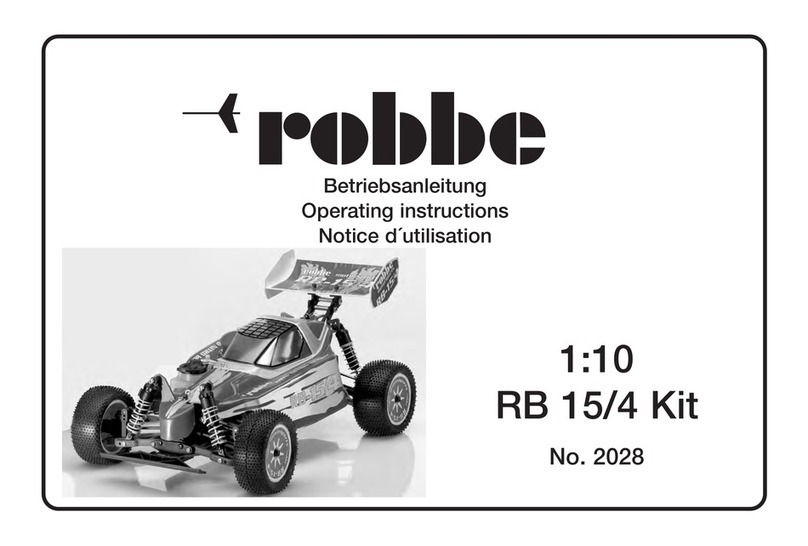
ROBBE
ROBBE RB 15/4 Kit User manual

ROBBE
ROBBE MAN F2000 Pritsche User manual
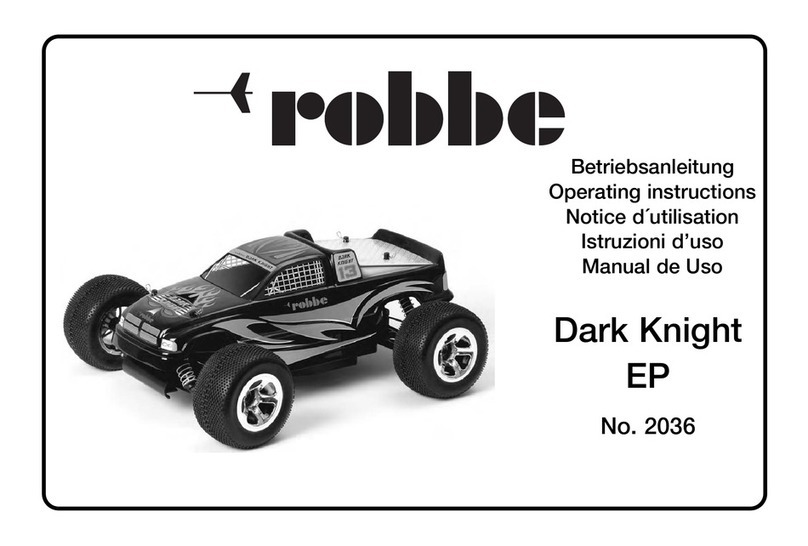
ROBBE
ROBBE Dark Knight EP 2036 User manual
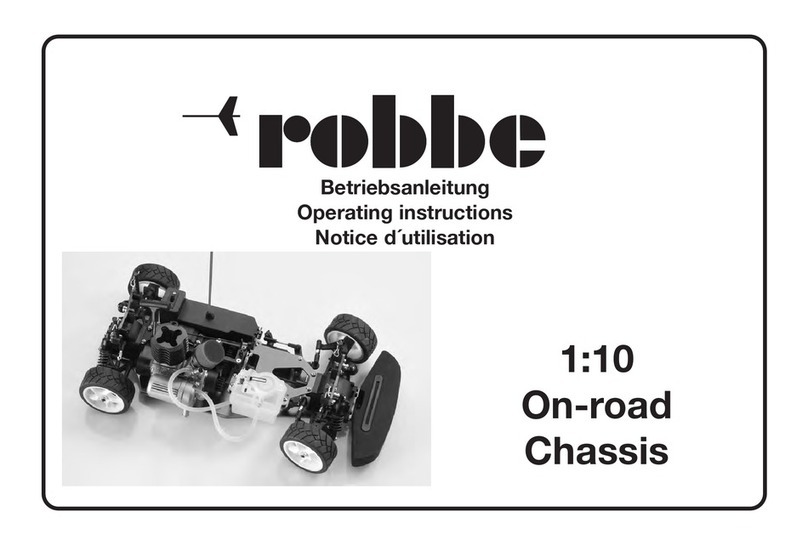
ROBBE
ROBBE S3003 User manual
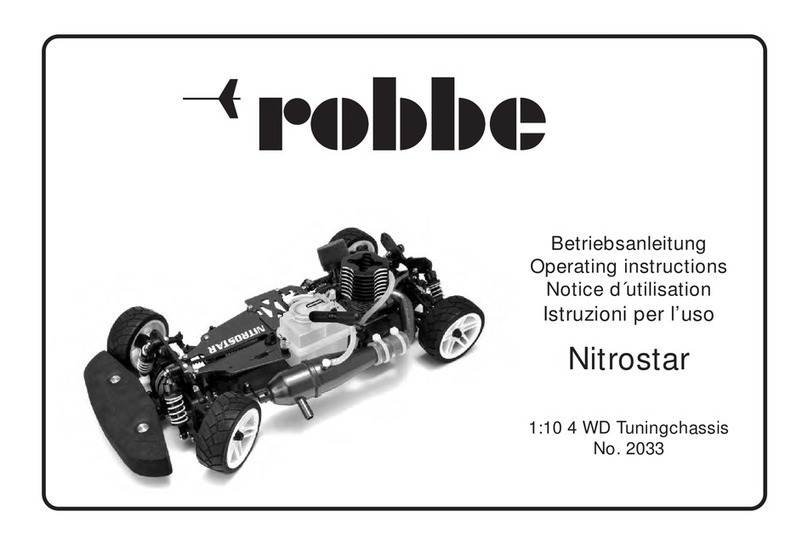
ROBBE
ROBBE 2033 User manual
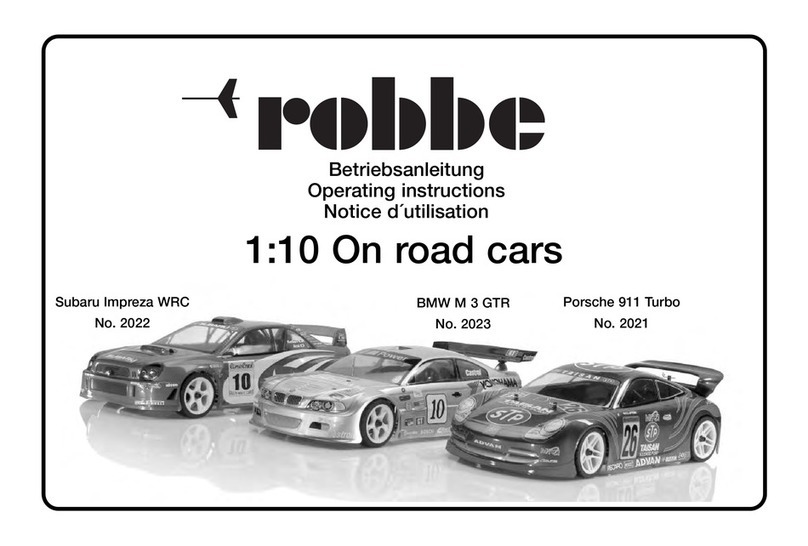
ROBBE
ROBBE Subaru Impreza WRC User manual
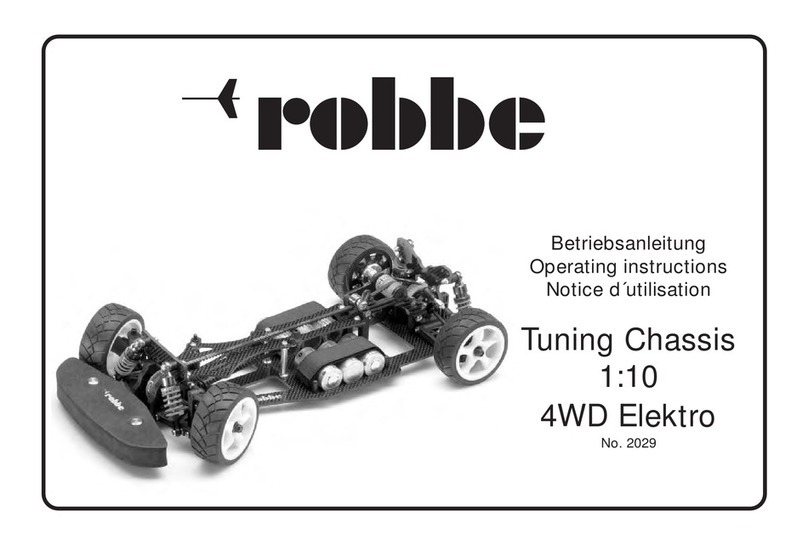
ROBBE
ROBBE Tunin chassis 1:10 4WD Elektro User manual
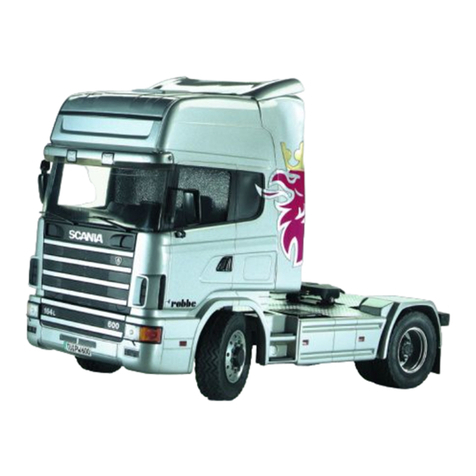
ROBBE
ROBBE 3374 User manual
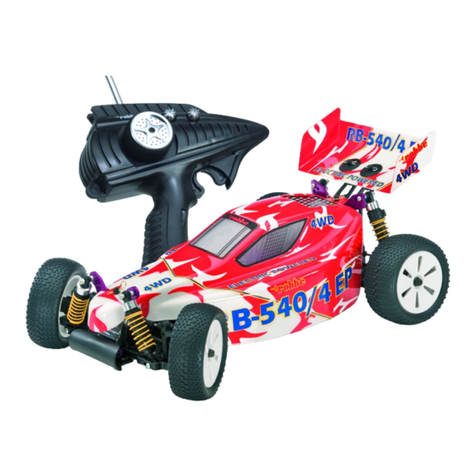
ROBBE
ROBBE Modellsport RB-540/4 EP User manual
